Overview
- Brief Narrative
- Sketch created by Alexander Bogen while he was a partisan fighter in the Naroch Forest in Belarussia during World War II. The sketch depicts one of his fellow partisans. Bogen was an art student in Vilna in 1941 when Germany invaded and occupied Lithuania and neighboring countries. In the Vilna ghetto, he sketched scenes of the life of his fellow Jews interned there by the Germans. “An artist doomed to death,” he said in later years, “recording and so preserving those doomed to death.” In 1943, he escaped the ghetto and joined the partisans, who carried out sabotage and other actions against the occupying German military. He helped lead the all-Jewish Nekama (Revenge) partisan brigade, and reentered the Vilna ghetto to help underground fighters escape as it was being liquidated by the Germans. When Lithuania was liberated in 1944 by Soviet forces, he returned to Vilna and resumed his studies.
- Artwork Title
- On the guard
- Date
-
creation:
1943
- Geography
-
depiction:
Naroch Forest;
Belarus
- Credit Line
- United States Holocaust Memorial Museum Collection, The Abraham and Ruth Goldfarb Family Acquisition Fund
- Signature
- front, lower right, in sanguine, in Cyrillic script : ABogen 43
- Contributor
-
Artist:
Alexander Bogen
Subject: Alexander Bogen
- Biography
-
Alexander Katzenbogen was born January 24, 1916, in Tartu, Estonia. His parents were both doctors. His father was from a secular Jewish background; his mother was the daughter of Rabbi Tuvia Lobitzki of Volkovysk, Poland (now in Belarus). When Alexander was two years old, the family moved to Vilna, Lithuania. The atmosphere in the home as he was growing up was liberal. His parents were socialists; he was a member of the Socialist-Zionist youth group Hashomer Hatzair. He married Rachel Shachor (b. 1914).
In 1941, Alexander was studying art at the University of Vilna. At that time, Vilna was under Soviet rule. On June 22, Germany invaded the Soviet Union and German planes bombed Vilna. Alexander and Rachel joined a large exodus from the city on foot toward the east. They got as far as Minsk, a distance of over a hundred miles, before German military activity forced them to turn back and return to Vilna. The journey east and then back to the west took months. Along the way, Alexander began sketching what he saw of the suffering of his fellow Jews under the new German occupation.
Alexander and Rachel were among the Jews confined to the Vilna ghetto, where Alexander joined the FPO, the Fareynikte Partizaner Organizatsye (United Partisan Organization), an underground organization inside the ghetto with paramilitary aspirations. He had the code name Shura. In addition to activities in the FPO, he sketched images of life in the ghetto. There was a debate within the FPO about whether to make a last stand against the Germans inside the ghetto, or to join partisans on the outside in the ongoing fight against the German occupation of the region. On July 29, 1943, a small band of FPO members, Alexander among them, escaped the ghetto and joined the Voroshilov brigade of partisans in the Naroch Forest, 60 miles to the east.
The majority of the partisans there were non-Jewish Russians. An all-Jewish unit was formed, called Nekhamah (Revenge). Alexander and other members of the unit distinguished themselves in paramilitary actions. Even under those conditions, Alexander sketched, using scraps of packing paper and charcoal made by burning dry branches. He sketched his fellow partisans, sometimes doing so as he and they were going into battle. In later years, he recalled, “Each man when he is standing face to face with cruel danger, with death, reacts in his way. The artist reacts with his means. This is his protest! This is my means! He reacts in an artistic way. This is his weapon.” The partisans produced a small newspaper on a mobile press. Alexander prepared woodcuts for the publication using his pen-knife.
At the beginning of September, 1943, a plan was formed for Alexander and a band of Jewish partisans to return to Vilna to infiltrate the ghetto and help potential fighters escape. The journey from the Naroch forest back to Vilna took a week. Along the way, Alexander’s group took food from peasants, sometimes at gunpoint. Once inside the ghetto, he reestablished contact with the FPO. German troops were in the final phase of liquidating the ghetto. Again, Alexander sketched what he observed. “We saw forsaken children. We saw people being taken to slaughter. I could not let my pencil fall. To tell about this to a world that was uninformed--to be creative in the situation of the Holocaust, this is also a protest.” On September 11, he helped lead 150 FPO members in an escape from the ghetto and on the journey to the Naroch Forest. His wife, Rachel, and her mother were also among the escapees.
Anti-Semitism by the Russian partisans made the position of the Jews among them difficult. Alexander was removed from military action and spent his time recording the history of the partisans by sketching their way of life. After the war, Alexander and Rachel returned to Vilna. Alexander returned to his studies and graduated in 1947, then he and his wife emigrated to Poland, where he became an award-winning artist. They had a son, Michael. In 1951, they made aliyah to Israel. During his career as an artist there, Alexander frequently used the subjects he had sketched during the war. Rachel died in 1998 at age 83 (or 84?), Alexander on October 20, 2010 at age 94.
Physical Details
- Language
- Russian
- Classification
-
Art
- Category
-
Drawings
- Object Type
-
Red chalk (aat)
- Physical Description
- Drawing in sanguine on roughly rectangular, brown paper. It depicts a man standing in left three-quarter profile, wearing a round hat and a long, belted coat, with his back against a tree, holding a rifle out in front of him by the stock with his extended left hand, with the butt resting on the ground. The artist’s signature and a year are in the lower right.
- Dimensions
- overall: Height: 11.880 inches (30.175 cm) | Width: 8.380 inches (21.285 cm)
- Materials
- overall : paper, red chalk, ink, graphite, pressure-sensitive tape
Rights & Restrictions
- Conditions on Access
- No restrictions on access
- Conditions on Use
- Restrictions on use
Keywords & Subjects
- Topical Term
- Guerillas--Belarus. Guerillas--Lithuania. Holocaust, Jewish (1939-1945), in art. Jewish ghettos--Lithuania--Vilnius. World War, 1939-1945--Jewish resistance--Belarus. World War, 1939-1945--Jewish resistance--Lithuania. World War, 1939-1945--Underground movements--Belarus. World War, 1939-1945--Underground movements--Lithuania.
- Personal Name
- Bogen, Alexander.
Administrative Notes
- Legal Status
- Permanent Collection
- Provenance
- The artwork was acquired by the United States Holocaust Memorial Museum in 2005.
- Funding Note
- The acquisition of this collection was made possible by The Abraham and Ruth Goldfarb Family Acquisition Fund.
- Record last modified:
- 2023-02-27 13:53:50
- This page:
- https://collections.ushmm.org/search/catalog/irn523107
Download & Licensing
In-Person Research
- By Appointment
- Request 21 Days in Advance of Visit
- Plan a Research Visit
- Request to See This Object
Contact Us
Also in Alexander Bogen collection
The collection consists of artwork created by Alexander Bogen during the Holocaust depicting his experiences in the ghetto in Vilnius, Lithuania (Vilna, Poland) and as a member of a partisan unit in the nearby forests.
Date: 1943-1944

Drawing by Alexander Bogen of a partisan with a rifle
Object
Sketch created by Alexander Bogen while he was a partisan fighter in the Naroch Forest in Belarussia during World War II. The sketch depicts one of his fellow partisans. Bogen was an art student in Vilna in 1941 when Germany invaded and occupied Lithuania and neighboring countries. In the Vilna ghetto, he sketched scenes of the life of his fellow Jews interned there by the Germans. “An artist doomed to death,” he said in later years, “recording and so preserving those doomed to death.” In 1943, he escaped the ghetto and joined the partisans, who carried out sabotage and other actions against the occupying German military. He helped lead the all-Jewish Nekama (Revenge) partisan brigade, and reentered the Vilna ghetto to help underground fighters escape as it was being liquidated by the Germans. When Lithuania was liberated in 1944 by Soviet forces, he returned to Vilna and resumed his studies.
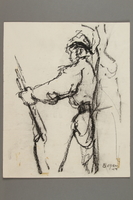
Drawing by Alexander Bogen of a partisan with a rifle
Object
Sketch created by Alexander Bogen while he was a partisan fighter in the Naroch Forest in Belarussia during World War II. The sketch depicts one of this fellow partisans. Bogen was an art student in Vilna in 1941 when Germany invaded and occupied Lithuania and neighboring countries. In the Vilna ghetto, he sketched scenes of the life of his fellow Jews interned there by the Germans. “An artist doomed to death,” he said in later years, “recording and so preserving those doomed to death.” In 1943, he escaped the ghetto and joined the partisans, who carried out sabotage and other actions against the occupying German military. He helped lead the all-Jewish Nekama (Revenge) partisan brigade, and reentered the Vilna ghetto to help underground fighters escape as it was being liquidated by the Germans. When Lithuania was liberated in 1944 by Soviet forces, he returned to Vilna and resumed his studies.
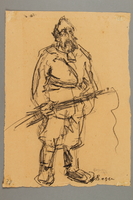
Drawing by Alexander Bogen of a bearded partisan
Object
Sketch created by Alexander Bogen while he was a partisan fighter in the Naroch Forest in Belarussia during World War II. The sketch depicts one of his fellow partisans. Bogen was an art student in Vilna in 1941 when Germany invaded and occupied Lithuania and neighboring countries. In the Vilna ghetto, he sketched scenes of the life of his fellow Jews interned there by the Germans. “An artist doomed to death,” he said in later years, “recording and so preserving those doomed to death.” In 1943, he escaped the ghetto and joined the partisans, who carried out sabotage and other actions against the occupying German military. He helped lead the all-Jewish Nekama (Revenge) partisan brigade, and reentered the Vilna ghetto to help underground fighters escape as it was being liquidated by the Germans. When Lithuania was liberated in 1944 by Soviet forces, he returned to Vilna and resumed his studies.

Drawing by Alexander Bogen of an armed partisan advancing
Object
Sketch created by Alexander Bogen while he was a partisan fighter in the Naroch Forest in Belarussia during World War II. The sketch depicts one of his fellow partisans. Bogen was an art student in Vilna in 1941 when Germany invaded and occupied Lithuania and neighboring countries. In the Vilna ghetto, he sketched scenes of the life of his fellow Jews interned there by the Germans. “An artist doomed to death,” he said in later years, “recording and so preserving those doomed to death.” In 1943, he escaped the ghetto and joined the partisans, who carried out sabotage and other actions against the occupying German military. He helped lead the all-Jewish Nekama (Revenge) partisan brigade, and reentered the Vilna ghetto to help underground fighters escape as it was being liquidated by the Germans. When Lithuania was liberated in 1944 by Soviet forces, he returned to Vilna and resumed his studies.
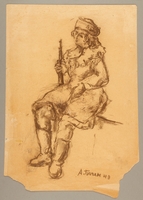
Drawing by Alexander Bogen of a female partisan sitting with a rifle
Object
Sketch created by Alexander Bogen while he was a partisan fighter in the Naroch Forest in Belarussia during World War II. The sketch depicts one of his fellow partisans. Bogen was an art student in Vilna in 1941 when Germany invaded and occupied Lithuania and neighboring countries. In the Vilna ghetto, he sketched scenes of the life of his fellow Jews interned there by the Germans. “An artist doomed to death,” he said in later years, “recording and so preserving those doomed to death.” In 1943, he escaped the ghetto and joined the partisans, who carried out sabotage and other actions against the occupying German military. He helped lead the all-Jewish Nekama (Revenge) partisan brigade, and reentered the Vilna ghetto to help underground fighters escape as it was being liquidated by the Germans. When Lithuania was liberated in 1944 by Soviet forces, he returned to Vilna and resumed his studies.
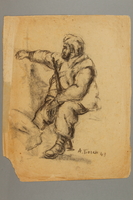
Drawing by Alexander Bogen of a bearded partisan sitting with a rifle between his knees
Object
Sketch created by Alexander Bogen while he was a partisan fighter in the Naroch Forest in Belarussia during World War II. The sketch depicts one of his fellow partisans. Bogen was an art student in Vilna in 1941 when Germany invaded and occupied Lithuania and neighboring countries. In the Vilna ghetto, he sketched scenes of the life of his fellow Jews interned there by the Germans. “An artist doomed to death,” he said in later years, “recording and so preserving those doomed to death.” In 1943, he escaped the ghetto and joined the partisans, who carried out sabotage and other actions against the occupying German military. He helped lead the all-Jewish Nekama (Revenge) partisan brigade, and reentered the Vilna ghetto to help underground fighters escape as it was being liquidated by the Germans. When Lithuania was liberated in 1944 by Soviet forces, he returned to Vilna and resumed his studies.
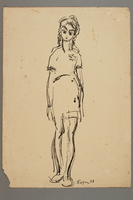
Drawing by Alexander Bogen of a girl wearing a six-pointed star
Object
Sketch created by Alexander Bogen, depicting a girl wearing a six-pointed star. Bogen was an art student in Vilna in 1941 when Germany invaded and occupied Lithuania and neighboring countries. In the Vilna ghetto, he sketched scenes of the life of his fellow Jews interned there by the Germans. “An artist doomed to death,” he said in later years, “recording and so preserving those doomed to death.” In 1943, he escaped the ghetto and joined the partisans in the Naroch Forest in Belarussia, who carried out sabotage and other actions against the occupying German military. He helped lead the all-Jewish Nekama (Revenge) partisan brigade, and reentered the Vilna ghetto to help underground fighters escape as it was being liquidated by the Germans. When Lithuania was liberated in 1944 by Soviet forces, he returned to Vilna and resumed his studies.
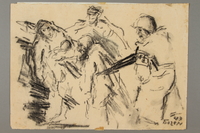
Drawing by Alexander Bogen of a German soldier herding a group of Jews at gunpoint
Object
Sketch created by Alexander Bogen, depicting a German soldier rounding up a group of Jews in the ghetto of Vilna, Lithuania. Bogen was an art student in Vilna in 1941 when Germany invaded and occupied Lithuania and neighboring countries. In the Vilna ghetto, he sketched scenes of the life of his fellow Jews interned there by the Germans. “An artist doomed to death,” he said in later years, “recording and so preserving those doomed to death.” In 1943, he escaped the ghetto and joined the partisans in the Naroch Forest in Belarussia, who carried out sabotage and other actions against the occupying German military. He helped lead the all-Jewish Nekama (Revenge) partisan brigade, and reentered the Vilna ghetto to help underground fighters escape as it was being liquidated by the Germans. When Lithuania was liberated in 1944 by Soviet forces, he returned to Vilna and resumed his studies.
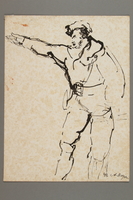
Drawing by Alexander Bogen of a partisan gesturing with his right arm
Object
Sketch created by Alexander Bogen while he was a partisan fighter in the Naroch Forest in Belarussia during World War II. The sketch depicts one of his fellow partisans. Bogen was an art student in Vilna in 1941 when Germany invaded and occupied Lithuania and neighboring countries. In the Vilna ghetto, he sketched scenes of the life of his fellow Jews interned there by the Germans. “An artist doomed to death,” he said in later years, “recording and so preserving those doomed to death.” In 1943, he escaped the ghetto and joined the partisans, who carried out sabotage and other actions against the occupying German military. He helped lead the all-Jewish Nekama (Revenge) partisan brigade, and reentered the Vilna ghetto to help underground fighters escape as it was being liquidated by the Germans. When Lithuania was liberated in 1944 by Soviet forces, he returned to Vilna and resumed his studies.
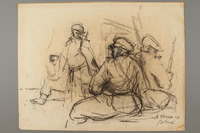
Drawing by Alexander Bogen of four partisans standing with rifles
Object
Sketch created by Alexander Bogen while he was a partisan fighter in the Naroch Forest in Belarussia during World War II. The sketch depicts a group of his fellow partisans. Bogen was an art student in Vilna in 1941 when Germany invaded and occupied Lithuania and neighboring countries. In the Vilna ghetto, he sketched scenes of the life of his fellow Jews interned there by the Germans. “An artist doomed to death,” he said in later years, “recording and so preserving those doomed to death.” In 1943, he escaped the ghetto and joined the partisans, who carried out sabotage and other actions against the occupying German military. He helped lead the all-Jewish Nekama (Revenge) partisan brigade, and reentered the Vilna ghetto to help underground fighters escape as it was being liquidated by the Germans. When Lithuania was liberated in 1944 by Soviet forces, he returned to Vilna and resumed his studies.

Portrait of a partisan, drawn by Alexander Bogen
Object
Sketch created by Alexander Bogen while he was a partisan fighter in the Naroch Forest in Belarussia during World War II. The sketch depicts one of his fellow partisans. Bogen was an art student in Vilna in 1941 when Germany invaded and occupied Lithuania and neighboring countries. In the Vilna ghetto, he sketched scenes of the life of his fellow Jews interned there by the Germans. “An artist doomed to death,” he said in later years, “recording and so preserving those doomed to death.” In 1943, he escaped the ghetto and joined the partisans, who carried out sabotage and other actions against the occupying German military. He helped lead the all-Jewish Nekama (Revenge) partisan brigade, and reentered the Vilna ghetto to help underground fighters escape as it was being liquidated by the Germans. When Lithuania was liberated in 1944 by Soviet forces, he returned to Vilna and resumed his studies.
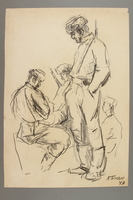
Drawing by Alexander Bogen of four partisans
Object
Sketch created by Alexander Bogen while he was a partisan fighter in the Naroch Forest in Belarussia during World War II. The sketch depicts a group of his fellow partisans. Bogen was an art student in Vilna in 1941 when Germany invaded and occupied Lithuania and neighboring countries. In the Vilna ghetto, he sketched scenes of the life of his fellow Jews interned there by the Germans. “An artist doomed to death,” he said in later years, “recording and so preserving those doomed to death.” In 1943, he escaped the ghetto and joined the partisans, who carried out sabotage and other actions against the occupying German military. He helped lead the all-Jewish Nekama (Revenge) partisan brigade, and reentered the Vilna ghetto to help underground fighters escape as it was being liquidated by the Germans. When Lithuania was liberated in 1944 by Soviet forces, he returned to Vilna and resumed his studies.
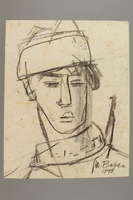
Portrait of a partisan, drawn by Alexander Bogen
Object
Sketch created by Alexander Bogen while he was a partisan fighter in the Naroch Forest in Belarussia during World War II. The sketch depicts one of his fellow partisans. Bogen was an art student in Vilna in 1941 when Germany invaded and occupied Lithuania and neighboring countries. In the Vilna ghetto, he sketched scenes of the life of his fellow Jews interned there by the Germans. “An artist doomed to death,” he said in later years, “recording and so preserving those doomed to death.” In 1943, he escaped the ghetto and joined the partisans, who carried out sabotage and other actions against the occupying German military. He helped lead the all-Jewish Nekama (Revenge) partisan brigade, and reentered the Vilna ghetto to help underground fighters escape as it was being liquidated by the Germans. When Lithuania was liberated in 1944 by Soviet forces, he returned to Vilna and resumed his studies.
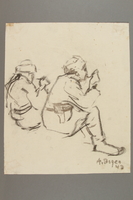
Drawing by Alexander Bogen of two partisans eating
Object
Sketch created by Alexander Bogen while he was a partisan fighter in the Naroch Forest in Belarussia during World War II. The sketch depicts two of his fellow partisans. Bogen was an art student in Vilna in 1941 when Germany invaded and occupied Lithuania and neighboring countries. In the Vilna ghetto, he sketched scenes of the life of his fellow Jews interned there by the Germans. “An artist doomed to death,” he said in later years, “recording and so preserving those doomed to death.” In 1943, he escaped the ghetto and joined the partisans, who carried out sabotage and other actions against the occupying German military. He helped lead the all-Jewish Nekama (Revenge) partisan brigade, and reentered the Vilna ghetto to help underground fighters escape as it was being liquidated by the Germans. When Lithuania was liberated in 1944 by Soviet forces, he returned to Vilna and resumed his studies.
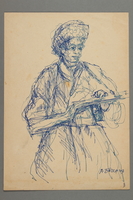
Drawing by Alexander Bogen of a partisan standing with a rifle
Object
Sketch created by Alexander Bogen while he was a partisan fighter in the Naroch Forest in Belarussia during World War II. The sketch depicts one of his fellow partisans. Bogen was an art student in Vilna in 1941 when Germany invaded and occupied Lithuania and neighboring countries. In the Vilna ghetto, he sketched scenes of the life of his fellow Jews interned there by the Germans. “An artist doomed to death,” he said in later years, “recording and so preserving those doomed to death.” In 1943, he escaped the ghetto and joined the partisans, who carried out sabotage and other actions against the occupying German military. He helped lead the all-Jewish Nekama (Revenge) partisan brigade, and reentered the Vilna ghetto to help underground fighters escape as it was being liquidated by the Germans. When Lithuania was liberated in 1944 by Soviet forces, he returned to Vilna and resumed his studies.
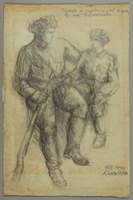
Drawing by Alexander Bogen of a man and boy in uniform seated together
Object
Sketch created by Alexander Bogen while he was a partisan fighter in the Naroch Forest in Belarussia during World War II. Bogen was an art student in Vilna in 1941 when Germany invaded and occupied Lithuania and neighboring countries. In the Vilna ghetto, he sketched scenes of the life of his fellow Jews interned there by the Germans. “An artist doomed to death,” he said in later years, “recording and so preserving those doomed to death.” In 1943, he escaped the ghetto and joined the partisans, who carried out sabotage and other actions against the occupying German military. He helped lead the all-Jewish Nekama (Revenge) partisan brigade, and reentered the Vilna ghetto to help underground fighters escape as it was being liquidated by the Germans. When Lithuania was liberated in 1944 by Soviet forces, he returned to Vilna and resumed his studies.
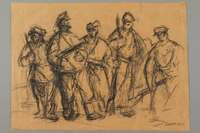
Drawing by Alexander Bogen of five partisans
Object
Sketch created by Alexander Bogen while he was a partisan fighter in the Naroch Forest in Belarussia during World War II. The sketch depicts a group of his fellow partisans. Bogen was an art student in Vilna in 1941 when Germany invaded and occupied Lithuania and neighboring countries. In the Vilna ghetto, he sketched scenes of the life of his fellow Jews interned there by the Germans. “An artist doomed to death,” he said in later years, “recording and so preserving those doomed to death.” In 1943, he escaped the ghetto and joined the partisans, who carried out sabotage and other actions against the occupying German military. He helped lead the all-Jewish Nekama (Revenge) partisan brigade, and reentered the Vilna ghetto to help underground fighters escape as it was being liquidated by the Germans. When Lithuania was liberated in 1944 by Soviet forces, he returned to Vilna and resumed his studies.
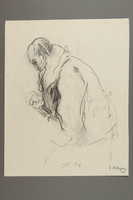
Drawing by Alexander Bogen of a man sitting in a heavy coat
Object
Sketch created by Alexander Bogen, depicting a Jew in the ghetto of Vilna, Lithuania. Bogen was an art student in Vilna in 1941 when Germany invaded and occupied Lithuania and neighboring countries. In the Vilna ghetto, he sketched scenes of the life of his fellow Jews interned there by the Germans. “An artist doomed to death,” he said in later years, “recording and so preserving those doomed to death.” In 1943, he escaped the ghetto and joined the partisans in the Naroch Forest in Belarussia, who carried out sabotage and other actions against the occupying German military. He helped lead the all-Jewish Nekama (Revenge) partisan brigade, and reentered the Vilna ghetto to help underground fighters escape as it was being liquidated by the Germans. When Lithuania was liberated in 1944 by Soviet forces, he returned to Vilna and resumed his studies.
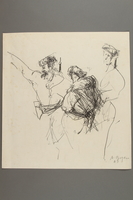
Drawing by Alexander Bogen of three partisans
Object
Sketch created by Alexander Bogen while he was a partisan fighter in the Naroch Forest in Belarussia during World War II. The sketch depicts a group of his fellow partisans. Bogen was an art student in Vilna in 1941 when Germany invaded and occupied Lithuania and neighboring countries. In the Vilna ghetto, he sketched scenes of the life of his fellow Jews interned there by the Germans. “An artist doomed to death,” he said in later years, “recording and so preserving those doomed to death.” In 1943, he escaped the ghetto and joined the partisans, who carried out sabotage and other actions against the occupying German military. He helped lead the all-Jewish Nekama (Revenge) partisan brigade, and reentered the Vilna ghetto to help underground fighters escape as it was being liquidated by the Germans. When Lithuania was liberated in 1944 by Soviet forces, he returned to Vilna and resumed his studies.
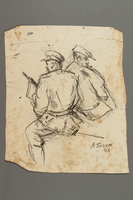
Drawing by Alexander Bogen of two partisans, one smoking a pipe
Object
Sketch created by Alexander Bogen while he was a partisan fighter in the Naroch Forest in Belarussia during World War II. The sketch depicts two of his fellow partisans. Bogen was an art student in Vilna in 1941 when Germany invaded and occupied Lithuania and neighboring countries. In the Vilna ghetto, he sketched scenes of the life of his fellow Jews interned there by the Germans. “An artist doomed to death,” he said in later years, “recording and so preserving those doomed to death.” In 1943, he escaped the ghetto and joined the partisans, who carried out sabotage and other actions against the occupying German military. He helped lead the all-Jewish Nekama (Revenge) partisan brigade, and reentered the Vilna ghetto to help underground fighters escape as it was being liquidated by the Germans. When Lithuania was liberated in 1944 by Soviet forces, he returned to Vilna and resumed his studies.
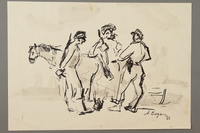
Drawing by Alexander Bogen of three armed partisans standing together in conversation
Object
Sketch created by Alexander Bogen while he was a partisan fighter in the Naroch Forest in Belarussia during World War II. The sketch depicts a group of his fellow partisans. Bogen was an art student in Vilna in 1941 when Germany invaded and occupied Lithuania and neighboring countries. In the Vilna ghetto, he sketched scenes of the life of his fellow Jews interned there by the Germans. “An artist doomed to death,” he said in later years, “recording and so preserving those doomed to death.” In 1943, he escaped the ghetto and joined the partisans, who carried out sabotage and other actions against the occupying German military. He helped lead the all-Jewish Nekama (Revenge) partisan brigade, and reentered the Vilna ghetto to help underground fighters escape as it was being liquidated by the Germans. When Lithuania was liberated in 1944 by Soviet forces, he returned to Vilna and resumed his studies.
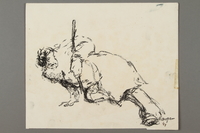
Drawing by Alexander Bogen of a partisan propping himself up with his rifle
Object
Sketch created by Alexander Bogen while he was a partisan fighter in the Naroch Forest in Belarussia during World War II. Bogen was an art student in Vilna in 1941 when Germany invaded and occupied Lithuania and neighboring countries. In the Vilna ghetto, he sketched scenes of the life of his fellow Jews interned there by the Germans. “An artist doomed to death,” he said in later years, “recording and so preserving those doomed to death.” In 1943, he escaped the ghetto and joined the partisans, who carried out sabotage and other actions against the occupying German military. He was a member of the all-Jewish Nekama (Revenge) partisan brigade, and reentered the Vilna ghetto to help underground fighters escape as it was being liquidated by the Germans. When Lithuania was liberated in 1944 by Soviet forces, he returned to Vilna and resumed his studies.
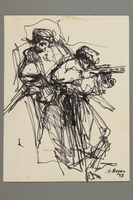
Drawing by Alexander Bogen of two partisans, one standing and one crouching and firing a rifle
Object
Sketch created by Alexander Bogen while he was a partisan fighter in the Naroch Forest in Belarussia during World War II. The sketch depicts two of his fellow partisans in battle. Bogen was an art student in Vilna in 1941 when Germany invaded and occupied Lithuania and neighboring countries. In the Vilna ghetto, he sketched scenes of the life of his fellow Jews interned there by the Germans. “An artist doomed to death,” he said in later years, “recording and so preserving those doomed to death.” In 1943, he escaped the ghetto and joined the partisans, who carried out sabotage and other actions against the occupying German military. He helped lead the all-Jewish Nekama (Revenge) partisan brigade, and reentered the Vilna ghetto to help underground fighters escape as it was being liquidated by the Germans. When Lithuania was liberated in 1944 by Soviet forces, he returned to Vilna and resumed his studies.
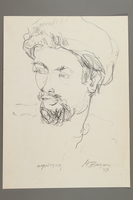
Drawing by Alexander Bogen of a partisan
Object
Sketch created by Alexander Bogen while he was a partisan fighter in the Naroch Forest in Belarussia during World War II. The sketch depicts one of his fellow partisans. Bogen was an art student in Vilna in 1941 when Germany invaded and occupied Lithuania and neighboring countries. In the Vilna ghetto, he sketched scenes of the life of his fellow Jews interned there by the Germans. “An artist doomed to death,” he said in later years, “recording and so preserving those doomed to death.” In 1943, he escaped the ghetto and joined the partisans, who carried out sabotage and other actions against the occupying German military. He helped lead the all-Jewish Nekama (Revenge) partisan brigade, and reentered the Vilna ghetto to help underground fighters escape as it was being liquidated by the Germans. When Lithuania was liberated in 1944 by Soviet forces, he returned to Vilna and resumed his studies.
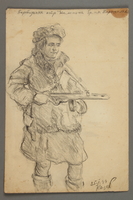
Drawing by Alexander Bogen of a female partisan standing and holding a rifle
Object
Sketch created by Alexander Bogen while he was a partisan fighter in the Naroch Forest in Belarussia during World War II. The sketch depicts one of his fellow partisans. Bogen was an art student in Vilna in 1941 when Germany invaded and occupied Lithuania and neighboring countries. In the Vilna ghetto, he sketched scenes of the life of his fellow Jews interned there by the Germans. “An artist doomed to death,” he said in later years, “recording and so preserving those doomed to death.” In 1943, he escaped the ghetto and joined the partisans, who carried out sabotage and other actions against the occupying German military. He helped lead the all-Jewish Nekama (Revenge) partisan brigade, and reentered the Vilna ghetto to help underground fighters escape as it was being liquidated by the Germans. When Lithuania was liberated in 1944 by Soviet forces, he returned to Vilna and resumed his studies.
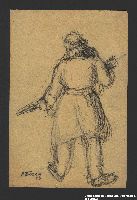
Drawing by Alexander Bogen of a partisan cradling a rifle in both arms
Object
Sketch created by Alexander Bogen while he was a partisan fighter in the Naroch Forest in Belarussia during World War II. The sketch depicts one of his fellow partisans. Bogen was an art student in Vilna in 1941 when Germany invaded and occupied Lithuania and neighboring countries. In the Vilna ghetto, he sketched scenes of the life of his fellow Jews interned there by the Germans. “An artist doomed to death,” he said in later years, “recording and so preserving those doomed to death.” In 1943, he escaped the ghetto and joined the partisans, who carried out sabotage and other actions against the occupying German military. He helped lead the all-Jewish Nekama (Revenge) partisan brigade, and reentered the Vilna ghetto to help underground fighters escape as it was being liquidated by the Germans. When Lithuania was liberated in 1944 by Soviet forces, he returned to Vilna and resumed his studies.

Portrait of a partisan, drawn by Alexander Bogen
Object
Sketch created by Alexander Bogen while he was a partisan fighter in the Naroch Forest in Belarussia during World War II. The sketch depicts one of his fellow partisans. Bogen was an art student in Vilna in 1941 when Germany invaded and occupied Lithuania and neighboring countries. In the Vilna ghetto, he sketched scenes of the life of his fellow Jews interned there by the Germans. “An artist doomed to death,” he said in later years, “recording and so preserving those doomed to death.” In 1943, he escaped the ghetto and joined the partisans, who carried out sabotage and other actions against the occupying German military. He helped lead the all-Jewish Nekama (Revenge) partisan brigade, and reentered the Vilna ghetto to help underground fighters escape as it was being liquidated by the Germans. When Lithuania was liberated in 1944 by Soviet forces, he returned to Vilna and resumed his studies.
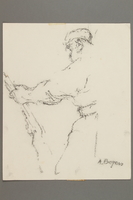
Drawing by Alexander Bogen of a partisan standing with a rifle
Object
Sketch created by Alexander Bogen while he was a partisan fighter in the Naroch Forest in Belarussia during World War II. The sketch depicts one of his fellow partisans. Bogen was an art student in Vilna in 1941 when Germany invaded and occupied Lithuania and neighboring countries. In the Vilna ghetto, he sketched scenes of the life of his fellow Jews interned there by the Germans. “An artist doomed to death,” he said in later years, “recording and so preserving those doomed to death.” In 1943, he escaped the ghetto and joined the partisans, who carried out sabotage and other actions against the occupying German military. He helped lead the all-Jewish Nekama (Revenge) partisan brigade, and reentered the Vilna ghetto to help underground fighters escape as it was being liquidated by the Germans. When Lithuania was liberated in 1944 by Soviet forces, he returned to Vilna and resumed his studies.
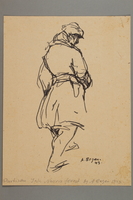
Drawing by Alexander Bogen of a partisan walking with his hands in his pockets
Object
Sketch created by Alexander Bogen while he was a partisan fighter in the Naroch Forest in Belarussia during World War II. The sketch depicts one of his fellow partisans. Bogen was an art student in Vilna in 1941 when Germany invaded and occupied Lithuania and neighboring countries. In the Vilna ghetto, he sketched scenes of the life of his fellow Jews interned there by the Germans. “An artist doomed to death,” he said in later years, “recording and so preserving those doomed to death.” In 1943, he escaped the ghetto and joined the partisans, who carried out sabotage and other actions against the occupying German military. He helped lead the all-Jewish Nekama (Revenge) partisan brigade, and reentered the Vilna ghetto to help underground fighters escape as it was being liquidated by the Germans. When Lithuania was liberated in 1944 by Soviet forces, he returned to Vilna and resumed his studies.
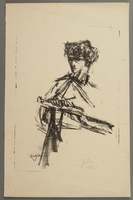
Lithograph by Alexander Bogen of a partisan
Object
Lithograph created by Alexander Bogen while he was a partisan fighter in the Naroch Forest in Belarussia during World War II. Bogen was an art student in Vilna in 1941 when Germany invaded and occupied Lithuania and neighboring countries. In the Vilna ghetto, he sketched scenes of the life of his fellow Jews interned there by the Germans. “An artist doomed to death,” he said in later years, “recording and so preserving those doomed to death.” In 1943, he escaped the ghetto and joined the partisans, who carried out sabotage and other actions against the occupying German military. He helped lead the all-Jewish Nekama (Revenge) partisan brigade, and reentered the Vilna ghetto to help underground fighters escape as it was being liquidated by the Germans. When Lithuania was liberated in 1944 by Soviet forces, he returned to Vilna and resumed his studies.
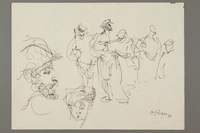
Drawing by Alexander Bogen of partisans in armed procession
Object
Sketch created by Alexander Bogen while he was a partisan fighter in the Naroch Forest in Belarussia during World War II. The sketch depicts a group of his fellow partisans. Bogen was an art student in Vilna in 1941 when Germany invaded and occupied Lithuania and neighboring countries. In the Vilna ghetto, he sketched scenes of the life of his fellow Jews interned there by the Germans. “An artist doomed to death,” he said in later years, “recording and so preserving those doomed to death.” In 1943, he escaped the ghetto and joined the partisans, who carried out sabotage and other actions against the occupying German military. He helped lead the all-Jewish Nekama (Revenge) partisan brigade, and reentered the Vilna ghetto to help underground fighters escape as it was being liquidated by the Germans. When Lithuania was liberated in 1944 by Soviet forces, he returned to Vilna and resumed his studies.
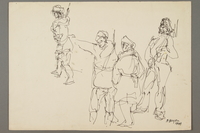
Drawing by Alexander Bogen of four armed partisans standing together
Object
Sketch created by Alexander Bogen while he was a partisan fighter in the Naroch Forest in Belarussia during World War II. The sketch depicts a group of his fellow partisans. Bogen was an art student in Vilna in 1941 when Germany invaded and occupied Lithuania and neighboring countries. In the Vilna ghetto, he sketched scenes of the life of his fellow Jews interned there by the Germans. “An artist doomed to death,” he said in later years, “recording and so preserving those doomed to death.” In 1943, he escaped the ghetto and joined the partisans, who carried out sabotage and other actions against the occupying German military. He helped lead the all-Jewish Nekama (Revenge) partisan brigade, and reentered the Vilna ghetto to help underground fighters escape as it was being liquidated by the Germans. When Lithuania was liberated in 1944 by Soviet forces, he returned to Vilna and resumed his studies.
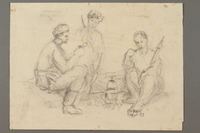
Drawing by Alexander Bogen of three partisans eating around a camp stove
Object
Sketch created by Alexander Bogen while he was a partisan fighter in the Naroch Forest in Belarussia during World War II. The sketch depicts a group of his fellow partisans. Bogen was an art student in Vilna in 1941 when Germany invaded and occupied Lithuania and neighboring countries. In the Vilna ghetto, he sketched scenes of the life of his fellow Jews interned there by the Germans. “An artist doomed to death,” he said in later years, “recording and so preserving those doomed to death.” In 1943, he escaped the ghetto and joined the partisans, who carried out sabotage and other actions against the occupying German military. He helped lead the all-Jewish Nekama (Revenge) partisan brigade, and reentered the Vilna ghetto to help underground fighters escape as it was being liquidated by the Germans. When Lithuania was liberated in 1944 by Soviet forces, he returned to Vilna and resumed his studies.
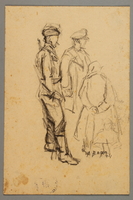
Drawing by Alexander Bogen of three partisans standing together in conversation
Object
Sketch created by Alexander Bogen while he was a partisan fighter in the Naroch Forest in Belarussia during World War II. Bogen was an art student in Vilna in 1941 when Germany invaded and occupied Lithuania and neighboring countries. In the Vilna ghetto, he sketched scenes of the life of his fellow Jews interned there by the Germans. “An artist doomed to death,” he said in later years, “recording and so preserving those doomed to death.” In 1943, he escaped the ghetto and joined the partisans, who carried out sabotage and other actions against the occupying German military. He helped lead the all-Jewish Nekama (Revenge) partisan brigade, and reentered the Vilna ghetto to help underground fighters escape as it was being liquidated by the Germans. When Lithuania was liberated in 1944 by Soviet forces, he returned to Vilna and resumed his studies.

Portrait of a bearded partisan, drawn by Alexander Bogen
Object
Sketch created by Alexander Bogen while he was a partisan fighter in the Naroch Forest in Belarussia during World War II. The sketch depicts one of his fellow partisans. Bogen was an art student in Vilna in 1941 when Germany invaded and occupied Lithuania and neighboring countries. In the Vilna ghetto, he sketched scenes of the life of his fellow Jews interned there by the Germans. “An artist doomed to death,” he said in later years, “recording and so preserving those doomed to death.” In 1943, he escaped the ghetto and joined the partisans, who carried out sabotage and other actions against the occupying German military. He helped lead the all-Jewish Nekama (Revenge) partisan brigade, and reentered the Vilna ghetto to help underground fighters escape as it was being liquidated by the Germans. When Lithuania was liberated in 1944 by Soviet forces, he returned to Vilna and resumed his studies.
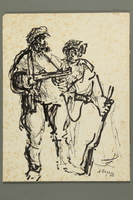
Drawing by Alexander Bogen of two partisans standing in conversation
Object
Sketch created by Alexander Bogen while he was a partisan fighter in the Naroch Forest in Belarussia during World War II. The sketch depicts two of his fellow partisans. Bogen was an art student in Vilna in 1941 when Germany invaded and occupied Lithuania and neighboring countries. In the Vilna ghetto, he sketched scenes of the life of his fellow Jews interned there by the Germans. “An artist doomed to death,” he said in later years, “recording and so preserving those doomed to death.” In 1943, he escaped the ghetto and joined the partisans, who carried out sabotage and other actions against the occupying German military. He helped lead the all-Jewish Nekama (Revenge) partisan brigade, and reentered the Vilna ghetto to help underground fighters escape as it was being liquidated by the Germans. When Lithuania was liberated in 1944 by Soviet forces, he returned to Vilna and resumed his studies.
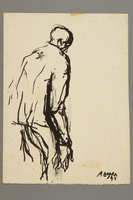
Drawing by Alexander Bogen of a man standing in a stooped posture
Object
Sketch created by Alexander Bogen, depicting a Jew in the ghetto in Vilna, Lithuania. Bogen was an art student in Vilna in 1941 when Germany invaded and occupied Lithuania and neighboring countries. In the Vilna ghetto, he sketched scenes of the life of his fellow Jews interned there by the Germans. “An artist doomed to death,” he said in later years, “recording and so preserving those doomed to death.” In 1943, he escaped the ghetto and joined the partisans in the Naroch Forest in Belarussia, who carried out sabotage and other actions against the occupying German military. He helped lead the all-Jewish Nekama (Revenge) partisan brigade, and reentered the Vilna ghetto to help underground fighters escape as it was being liquidated by the Germans. When Lithuania was liberated in 1944 by Soviet forces, he returned to Vilna and resumed his studies.
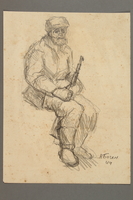
Drawing by Alexander Bogen of a bearded partisan, seated and holding a rifle
Object
Sketch created by Alexander Bogen while he was a partisan fighter in the Naroch Forest in Belarussia during World War II. The sketch depicts one of his fellow partisans. Bogen was an art student in Vilna in 1941 when Germany invaded and occupied Lithuania and neighboring countries. In the Vilna ghetto, he sketched scenes of the life of his fellow Jews interned there by the Germans. “An artist doomed to death,” he said in later years, “recording and so preserving those doomed to death.” In 1943, he escaped the ghetto and joined the partisans, who carried out sabotage and other actions against the occupying German military. He helped lead the all-Jewish Nekama (Revenge) partisan brigade, and reentered the Vilna ghetto to help underground fighters escape as it was being liquidated by the Germans. When Lithuania was liberated in 1944 by Soviet forces, he returned to Vilna and resumed his studies.
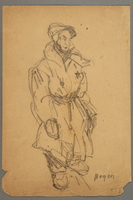
Drawing by Alexander Bogen of a man wearing a six-pointed star
Object
Sketch created by Alexander Bogen, depicting a man wearing a six-pointed star. Bogen was an art student in Vilna in 1941 when Germany invaded and occupied Lithuania and neighboring countries. In the Vilna ghetto, he sketched scenes of the life of his fellow Jews interned there by the Germans. “An artist doomed to death,” he said in later years, “recording and so preserving those doomed to death.” In 1943, he escaped the ghetto and joined the partisans in the Naroch Forest in Belarussia, who carried out sabotage and other actions against the occupying German military. He helped lead the all-Jewish Nekama (Revenge) partisan brigade, and reentered the Vilna ghetto to help underground fighters escape as it was being liquidated by the Germans. When Lithuania was liberated in 1944 by Soviet forces, he returned to Vilna and resumed his studies.
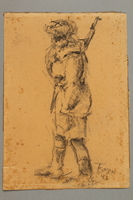
Drawing by Alexander Bogen of a female partisan
Object
Sketch created by Alexander Bogen while he was a partisan fighter in the Naroch Forest in Belarussia during World War II. The sketch depicts one of his fellow partisans. Bogen was an art student in Vilna in 1941 when Germany invaded and occupied Lithuania and neighboring countries. In the Vilna ghetto, he sketched scenes of the life of his fellow Jews interned there by the Germans. “An artist doomed to death,” he said in later years, “recording and so preserving those doomed to death.” In 1943, he escaped the ghetto and joined the partisans, who carried out sabotage and other actions against the occupying German military. He helped lead the all-Jewish Nekama (Revenge) partisan brigade, and reentered the Vilna ghetto to help underground fighters escape as it was being liquidated by the Germans. When Lithuania was liberated in 1944 by Soviet forces, he returned to Vilna and resumed his studies.
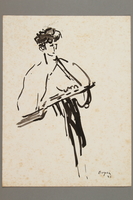
Drawing by Alexander Bogen of a partisan standing with a rifle
Object
Sketch created by Alexander Bogen while he was a partisan fighter in the Naroch Forest in Belarussia during World War II. Bogen was an art student in Vilna in 1941 when Germany invaded and occupied Lithuania and neighboring countries. In the Vilna ghetto, he sketched scenes of the life of his fellow Jews interned there by the Germans. “An artist doomed to death,” he said in later years, “recording and so preserving those doomed to death.” In 1943, he escaped the ghetto and joined the partisans, who carried out sabotage and other actions against the occupying German military. He helped lead the all-Jewish Nekama (Revenge) partisan brigade, and reentered the Vilna ghetto to help underground fighters escape as it was being liquidated by the Germans. When Lithuania was liberated in 1944 by Soviet forces, he returned to Vilna and resumed his studies.
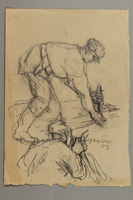
Drawing by Alexander Bogen of two partisans crouched on the ground, working with a tool
Object
Sketch created by Alexander Bogen while he was a partisan fighter in the Naroch Forest in Belarussia during World War II. The sketch depicts two of his fellow partisans sabotaging a railroad track. Bogen was an art student in Vilna in 1941 when Germany invaded and occupied Lithuania and neighboring countries. In the Vilna ghetto, he sketched scenes of the life of his fellow Jews interned there by the Germans. “An artist doomed to death,” he said in later years, “recording and so preserving those doomed to death.” In 1943, he escaped the ghetto and joined the partisans, who carried out sabotage and other actions against the occupying German military. He helped lead the all-Jewish Nekama (Revenge) partisan brigade, and reentered the Vilna ghetto to help underground fighters escape as it was being liquidated by the Germans. When Lithuania was liberated in 1944 by Soviet forces, he returned to Vilna and resumed his studies.
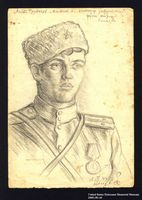
Portrait of a partisan in uniform, drawn by Alexander Bogen
Object
Sketch created by Alexander Bogen while he was a partisan fighter in the Naroch Forest in Belarussia during World War II. Bogen was an art student in Vilna in 1941 when Germany invaded and occupied Lithuania and neighboring countries. In the Vilna ghetto, he sketched scenes of the life of his fellow Jews interned there by the Germans. “An artist doomed to death,” he said in later years, “recording and so preserving those doomed to death.” In 1943, he escaped the ghetto and joined the partisans, who carried out sabotage and other actions against the occupying German military. He helped lead the all-Jewish Nekama (Revenge) partisan brigade, and reentered the Vilna ghetto to help underground fighters escape as it was being liquidated by the Germans. When Lithuania was liberated in 1944 by Soviet forces, he returned to Vilna and resumed his studies.
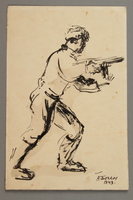
Drawing by Alexander Bogen of a partisan advancing with a rifle
Object
Sketch created by Alexander Bogen while he was a partisan fighter in the Naroch Forest in Belarussia during World War II. The sketch depicts one of his fellow partisans. Bogen was an art student in Vilna in 1941 when Germany invaded and occupied Lithuania and neighboring countries. In the Vilna ghetto, he sketched scenes of the life of his fellow Jews interned there by the Germans. “An artist doomed to death,” he said in later years, “recording and so preserving those doomed to death.” In 1943, he escaped the ghetto and joined the partisans, who carried out sabotage and other actions against the occupying German military. He helped lead the all-Jewish Nekama (Revenge) partisan brigade, and reentered the Vilna ghetto to help underground fighters escape as it was being liquidated by the Germans. When Lithuania was liberated in 1944 by Soviet forces, he returned to Vilna and resumed his studies.
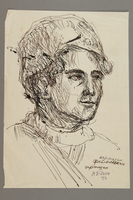
Portrait of a partisan, drawn by Alexander Bogen
Object
Sketch created by Alexander Bogen while he was a partisan fighter in the Naroch Forest in Belarussia during World War II. Bogen was an art student in Vilna in 1941 when Germany invaded and occupied Lithuania and neighboring countries. In the Vilna ghetto, he sketched scenes of the life of his fellow Jews interned there by the Germans. “An artist doomed to death,” he said in later years, “recording and so preserving those doomed to death.” In 1943, he escaped the ghetto and joined the partisans, who carried out sabotage and other actions against the occupying German military. He helped lead the all-Jewish Nekama (Revenge) partisan brigade, and reentered the Vilna ghetto to help underground fighters escape as it was being liquidated by the Germans. When Lithuania was liberated in 1944 by Soviet forces, he returned to Vilna and resumed his studies.
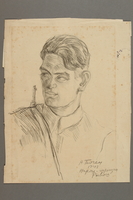
Portrait of a partisan, drawn by Alexander Bogen
Object
Sketch created by Alexander Bogen while he was a partisan fighter in the Naroch Forest in Belarussia during World War II. Bogen was an art student in Vilna in 1941 when Germany invaded and occupied Lithuania and neighboring countries. In the Vilna ghetto, he sketched scenes of the life of his fellow Jews interned there by the Germans. “An artist doomed to death,” he said in later years, “recording and so preserving those doomed to death.” In 1943, he escaped the ghetto and joined the partisans, who carried out sabotage and other actions against the occupying German military. He helped lead the all-Jewish Nekama (Revenge) partisan brigade, and reentered the Vilna ghetto to help underground fighters escape as it was being liquidated by the Germans. When Lithuania was liberated in 1944 by Soviet forces, he returned to Vilna and resumed his studies.
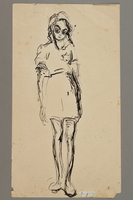
Drawing by Alexander Bogen of a girl wearing a six-pointed star
Object
Sketch created by Alexander Bogen, depicting a girl wearing a six-pointed star. Bogen was an art student in Vilna in 1941 when Germany invaded and occupied Lithuania and neighboring countries. In the Vilna ghetto, he sketched scenes of the life of his fellow Jews interned there by the Germans. “An artist doomed to death,” he said in later years, “recording and so preserving those doomed to death.” In 1943, he escaped the ghetto and joined the partisans in the Naroch Forest in Belarussia, who carried out sabotage and other actions against the occupying German military. He helped lead the all-Jewish Nekama (Revenge) partisan brigade, and reentered the Vilna ghetto to help underground fighters escape as it was being liquidated by the Germans. When Lithuania was liberated in 1944 by Soviet forces, he returned to Vilna and resumed his studies.

Drawing by Alexander Bogen of an old man wearing a six-pointed star
Object
Sketch created by Alexander Bogen, depicting and elderly man wearing a six-pointed star. Bogen was an art student in Vilna in 1941 when Germany invaded and occupied Lithuania and neighboring countries. In the Vilna ghetto, he sketched scenes of the life of his fellow Jews interned there by the Germans. “An artist doomed to death,” he said in later years, “recording and so preserving those doomed to death.” In 1943, he escaped the ghetto and joined the partisans in the Naroch Forest in Belarussia, who carried out sabotage and other actions against the occupying German military. He helped lead the all-Jewish Nekama (Revenge) partisan brigade, and reentered the Vilna ghetto to help underground fighters escape as it was being liquidated by the Germans. When Lithuania was liberated in 1944 by Soviet forces, he returned to Vilna and resumed his studies.

Portrait of a partisan, drawn by Alexander Bogen
Object
Sketch created by Alexander Bogen while he was a partisan fighter in the Naroch Forest in Belarussia during World War II. Bogen was an art student in Vilna in 1941 when Germany invaded and occupied Lithuania and neighboring countries. In the Vilna ghetto, he sketched scenes of the life of his fellow Jews interned there by the Germans. “An artist doomed to death,” he said in later years, “recording and so preserving those doomed to death.” In 1943, he escaped the ghetto and joined the partisans, who carried out sabotage and other actions against the occupying German military. He helped lead the all-Jewish Nekama (Revenge) partisan brigade, and reentered the Vilna ghetto to help underground fighters escape as it was being liquidated by the Germans. When Lithuania was liberated in 1944 by Soviet forces, he returned to Vilna and resumed his studies.

Portrait of a partisan with a mustache, drawn by Alexander Bogen
Object
Sketch created by Alexander Bogen while he was a partisan fighter in the Naroch Forest in Belarussia during World War II. Bogen was an art student in Vilna in 1941 when Germany invaded and occupied Lithuania and neighboring countries. In the Vilna ghetto, he sketched scenes of the life of his fellow Jews interned there by the Germans. “An artist doomed to death,” he said in later years, “recording and so preserving those doomed to death.” In 1943, he escaped the ghetto and joined the partisans, who carried out sabotage and other actions against the occupying German military. He helped lead the all-Jewish Nekama (Revenge) partisan brigade, and reentered the Vilna ghetto to help underground fighters escape as it was being liquidated by the Germans. When Lithuania was liberated in 1944 by Soviet forces, he returned to Vilna and resumed his studies.
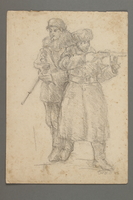
Drawing by Alexander Bogen of two armed partisans standing together
Object
Sketch created by Alexander Bogen while he was a partisan fighter in the Naroch Forest in Belarussia during World War II. The sketch depicts two of his fellow partisans. Bogen was an art student in Vilna in 1941 when Germany invaded and occupied Lithuania and neighboring countries. In the Vilna ghetto, he sketched scenes of the life of his fellow Jews interned there by the Germans. “An artist doomed to death,” he said in later years, “recording and so preserving those doomed to death.” In 1943, he escaped the ghetto and joined the partisans, who carried out sabotage and other actions against the occupying German military. He helped lead the all-Jewish Nekama (Revenge) partisan brigade, and reentered the Vilna ghetto to help underground fighters escape as it was being liquidated by the Germans. When Lithuania was liberated in 1944 by Soviet forces, he returned to Vilna and resumed his studies.
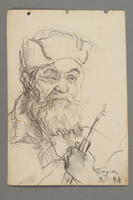
Portrait of a bearded partisan, drawn by Alexander Bogen
Object
Sketch created by Alexander Bogen while he was a partisan fighter in the Naroch Forest in Belarussia during World War II. Bogen was an art student in Vilna in 1941 when Germany invaded and occupied Lithuania and neighboring countries. In the Vilna ghetto, he sketched scenes of the life of his fellow Jews interned there by the Germans. “An artist doomed to death,” he said in later years, “recording and so preserving those doomed to death.” In 1943, he escaped the ghetto and joined the partisans, who carried out sabotage and other actions against the occupying German military. He helped lead the all-Jewish Nekama (Revenge) partisan brigade, and reentered the Vilna ghetto to help underground fighters escape as it was being liquidated by the Germans. When Lithuania was liberated in 1944 by Soviet forces, he returned to Vilna and resumed his studies.
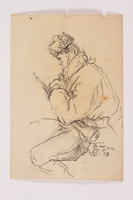
Drawing by Alexander Bogen of a partisan sitting with a rifle across his lap
Object
Sketch created by Alexander Bogen while he was a partisan fighter in the Naroch Forest in Belarussia during World War II. The sketch depicts one of his fellow partisans. Bogen was an art student in Vilna in 1941 when Germany invaded and occupied Lithuania and neighboring countries. In the Vilna ghetto, he sketched scenes of the life of his fellow Jews interned there by the Germans. “An artist doomed to death,” he said in later years, “recording and so preserving those doomed to death.” In 1943, he escaped the ghetto and joined the partisans, who carried out sabotage and other actions against the occupying German military. He helped lead the all-Jewish Nekama (Revenge) partisan brigade, and reentered the Vilna ghetto to help underground fighters escape as it was being liquidated by the Germans. When Lithuania was liberated in 1944 by Soviet forces, he returned to Vilna and resumed his studies.
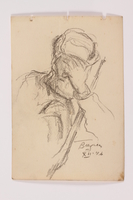
Drawing by Alexander Bogen of a partisan sitting with his hand over his face
Object
Sketch created by Alexander Bogen while he was a partisan fighter in the Naroch Forest in Belarussia during World War II. The sketch depicts one of his fellow partisans. Bogen was an art student in Vilna in 1941 when Germany invaded and occupied Lithuania and neighboring countries. In the Vilna ghetto, he sketched scenes of the life of his fellow Jews interned there by the Germans. “An artist doomed to death,” he said in later years, “recording and so preserving those doomed to death.” In 1943, he escaped the ghetto and joined the partisans, who carried out sabotage and other actions against the occupying German military. He helped lead the all-Jewish Nekama (Revenge) partisan brigade, and reentered the Vilna ghetto to help underground fighters escape as it was being liquidated by the Germans. When Lithuania was liberated in 1944 by Soviet forces, he returned to Vilna and resumed his studies.
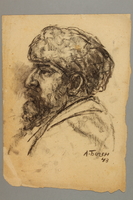
Portrait of a bearded partisan, drawn by Alexander Bogen
Object
Sketch created by Alexander Bogen while he was a partisan fighter in the Naroch Forest in Belarussia during World War II. Bogen was an art student in Vilna in 1941 when Germany invaded and occupied Lithuania and neighboring countries. In the Vilna ghetto, he sketched scenes of the life of his fellow Jews interned there by the Germans. “An artist doomed to death,” he said in later years, “recording and so preserving those doomed to death.” In 1943, he escaped the ghetto and joined the partisans, who carried out sabotage and other actions against the occupying German military. He helped lead the all-Jewish Nekama (Revenge) partisan brigade, and reentered the Vilna ghetto to help underground fighters escape as it was being liquidated by the Germans. When Lithuania was liberated in 1944 by Soviet forces, he returned to Vilna and resumed his studies.
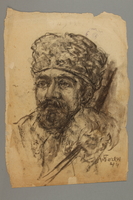
Portrait of a partisan with a goatee, drawn by Alexander Bogen
Object
Sketch created by Alexander Bogen while he was a partisan fighter in the Naroch Forest in Belarussia during World War II. Bogen was an art student in Vilna in 1941 when Germany invaded and occupied Lithuania and neighboring countries. In the Vilna ghetto, he sketched scenes of the life of his fellow Jews interned there by the Germans. “An artist doomed to death,” he said in later years, “recording and so preserving those doomed to death.” In 1943, he escaped the ghetto and joined the partisans, who carried out sabotage and other actions against the occupying German military. He helped lead the all-Jewish Nekama (Revenge) partisan brigade, and reentered the Vilna ghetto to help underground fighters escape as it was being liquidated by the Germans. When Lithuania was liberated in 1944 by Soviet forces, he returned to Vilna and resumed his studies.
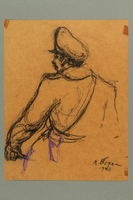
Drawing by Alexander Bogen of an SS officer
Object
Sketch created by Alexander Bogen, depicting an German officer. Bogen was an art student in Vilna in 1941 when Germany invaded and occupied Lithuania and neighboring countries. In the Vilna ghetto, he sketched scenes of the life of his fellow Jews interned there by the Germans. “An artist doomed to death,” he said in later years, “recording and so preserving those doomed to death.” In 1943, he escaped the ghetto and joined the partisans in the Naroch Forest in Belarussia, who carried out sabotage and other actions against the occupying German military. He helped lead the all-Jewish Nekama (Revenge) partisan brigade, and reentered the Vilna ghetto to help underground fighters escape as it was being liquidated by the Germans. When Lithuania was liberated in 1944 by Soviet forces, he returned to Vilna and resumed his studies.
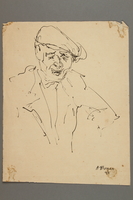
Portrait of a man in a cap, drawn by Alexander Bogen
Object
Sketch created by Alexander Bogen, depicting a Jewish man interned in the ghetto in Vilna, Lithuania. Bogen was an art student in Vilna in 1941 when Germany invaded and occupied Lithuania and neighboring countries. In the Vilna ghetto, he sketched scenes of the life of his fellow Jews interned there by the Germans. “An artist doomed to death,” he said in later years, “recording and so preserving those doomed to death.” In 1943, he escaped the ghetto and joined the partisans in the Naroch Forest in Belarussia, who carried out sabotage and other actions against the occupying German military. He helped lead the all-Jewish Nekama (Revenge) partisan brigade, and reentered the Vilna ghetto to help underground fighters escape as it was being liquidated by the Germans. When Lithuania was liberated in 1944 by Soviet forces, he returned to Vilna and resumed his studies.

Drawing by Alexander Bogen of a man wearing a six-pointed star on the back of his coat
Object
Sketch created by Alexander Bogen, depicting a man wearing a six-pointed star. Bogen was an art student in Vilna in 1941 when Germany invaded and occupied Lithuania and neighboring countries. In the Vilna ghetto, he sketched scenes of the life of his fellow Jews interned there by the Germans. “An artist doomed to death,” he said in later years, “recording and so preserving those doomed to death.” In 1943, he escaped the ghetto and joined the partisans in the Naroch Forest in Belarussia, who carried out sabotage and other actions against the occupying German military. He helped lead the all-Jewish Nekama (Revenge) partisan brigade, and reentered the Vilna ghetto to help underground fighters escape as it was being liquidated by the Germans. When Lithuania was liberated in 1944 by Soviet forces, he returned to Vilna and resumed his studies.
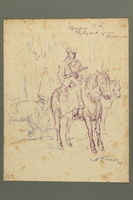
Drawing by Alexander Bogen of a partisan on a horse
Object
Sketch created by Alexander Bogen while he was a partisan fighter in the Naroch Forest in Belarussia during World War II. The sketch depicts one of his fellow partisans. Bogen was an art student in Vilna in 1941 when Germany invaded and occupied Lithuania and neighboring countries. In the Vilna ghetto, he sketched scenes of the life of his fellow Jews interned there by the Germans. “An artist doomed to death,” he said in later years, “recording and so preserving those doomed to death.” In 1943, he escaped the ghetto and joined the partisans, who carried out sabotage and other actions against the occupying German military. He helped lead the all-Jewish Nekama (Revenge) partisan brigade, and reentered the Vilna ghetto to help underground fighters escape as it was being liquidated by the Germans. When Lithuania was liberated in 1944 by Soviet forces, he returned to Vilna and resumed his studies.
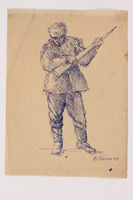
Drawing by Alexander Bogen of a partisan standing with a rifle
Object
Sketch created by Alexander Bogen while he was a partisan fighter in the Naroch Forest in Belarussia during World War II. The sketch depicts one of his fellow partisans. Bogen was an art student in Vilna in 1941 when Germany invaded and occupied Lithuania and neighboring countries. In the Vilna ghetto, he sketched scenes of the life of his fellow Jews interned there by the Germans. “An artist doomed to death,” he said in later years, “recording and so preserving those doomed to death.” In 1943, he escaped the ghetto and joined the partisans, who carried out sabotage and other actions against the occupying German military. He helped lead the all-Jewish Nekama (Revenge) partisan brigade, and reentered the Vilna ghetto to help underground fighters escape as it was being liquidated by the Germans. When Lithuania was liberated in 1944 by Soviet forces, he returned to Vilna and resumed his studies.
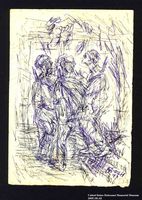
Drawing by Alexander Bogen of four partisans standing together in the woods
Object
Sketch created by Alexander Bogen while he was a partisan fighter in the Naroch Forest in Belarussia during World War II. The sketch depicts a group of his fellow partisans. Bogen was an art student in Vilna in 1941 when Germany invaded and occupied Lithuania and neighboring countries. In the Vilna ghetto, he sketched scenes of the life of his fellow Jews interned there by the Germans. “An artist doomed to death,” he said in later years, “recording and so preserving those doomed to death.” In 1943, he escaped the ghetto and joined the partisans, who carried out sabotage and other actions against the occupying German military. He helped lead the all-Jewish Nekama (Revenge) partisan brigade, and reentered the Vilna ghetto to help underground fighters escape as it was being liquidated by the Germans. When Lithuania was liberated in 1944 by Soviet forces, he returned to Vilna and resumed his studies.
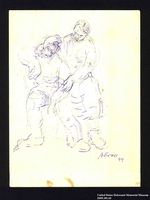
Drawing by Alexander Bogen of a standing person holding and comforting a seated person
Object
Sketch created by Alexander Bogen while he was a partisan fighter in the Naroch Forest in Belarussia during World War II. Bogen was an art student in Vilna in 1941 when Germany invaded and occupied Lithuania and neighboring countries. In the Vilna ghetto, he sketched scenes of the life of his fellow Jews interned there by the Germans. “An artist doomed to death,” he said in later years, “recording and so preserving those doomed to death.” In 1943, he escaped the ghetto and joined the partisans, who carried out sabotage and other actions against the occupying German military. He helped lead the all-Jewish Nekama (Revenge) partisan brigade, and reentered the Vilna ghetto to help underground fighters escape as it was being liquidated by the Germans. When Lithuania was liberated in 1944 by Soviet forces, he returned to Vilna and resumed his studies.
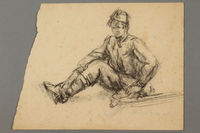
Drawing by Alexander Bogen of a partisan with an amputated left leg
Object
Sketch created by Alexander Bogen while he was a partisan fighter in the Naroch Forest in Belarussia during World War II. Bogen was an art student in Vilna in 1941 when Germany invaded and occupied Lithuania and neighboring countries. In the Vilna ghetto, he sketched scenes of the life of his fellow Jews interned there by the Germans. “An artist doomed to death,” he said in later years, “recording and so preserving those doomed to death.” In 1943, he escaped the ghetto and joined the partisans, who carried out sabotage and other actions against the occupying German military. He helped lead the all-Jewish Nekama (Revenge) partisan brigade, and reentered the Vilna ghetto to help underground fighters escape as it was being liquidated by the Germans. When Lithuania was liberated in 1944 by Soviet forces, he returned to Vilna and resumed his studies.
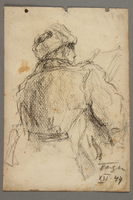
Drawing by Alexander Bogen of a partisan sitting and reading
Object
Sketch created by Alexander Bogen while he was a partisan fighter in the Naroch Forest in Belarussia during World War II. Bogen was an art student in Vilna in 1941 when Germany invaded and occupied Lithuania and neighboring countries. In the Vilna ghetto, he sketched scenes of the life of his fellow Jews interned there by the Germans. “An artist doomed to death,” he said in later years, “recording and so preserving those doomed to death.” In 1943, he escaped the ghetto and joined the partisans, who carried out sabotage and other actions against the occupying German military. He helped lead the all-Jewish Nekama (Revenge) partisan brigade, and reentered the Vilna ghetto to help underground fighters escape as it was being liquidated by the Germans. When Lithuania was liberated in 1944 by Soviet forces, he returned to Vilna and resumed his studies.
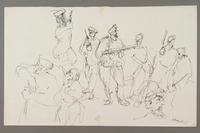
Drawing by Alexander Bogen of nine partisans in a group
Object
Sketch created by Alexander Bogen while he was a partisan fighter in the Naroch Forest in Belarussia during World War II. Bogen was an art student in Vilna in 1941 when Germany invaded and occupied Lithuania and neighboring countries. In the Vilna ghetto, he sketched scenes of the life of his fellow Jews interned there by the Germans. “An artist doomed to death,” he said in later years, “recording and so preserving those doomed to death.” In 1943, he escaped the ghetto and joined the partisans, who carried out sabotage and other actions against the occupying German military. He helped lead the all-Jewish Nekama (Revenge) partisan brigade, and reentered the Vilna ghetto to help underground fighters escape as it was being liquidated by the Germans. When Lithuania was liberated in 1944 by Soviet forces, he returned to Vilna and resumed his studies.
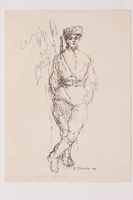
Drawing by Alexander Bogen of a partisan leaning against a tree with his hands in his pockets
Object
Sketch created by Alexander Bogen while he was a partisan fighter in the Naroch Forest in Belarussia during World War II. Bogen was an art student in Vilna in 1941 when Germany invaded and occupied Lithuania and neighboring countries. In the Vilna ghetto, he sketched scenes of the life of his fellow Jews interned there by the Germans. “An artist doomed to death,” he said in later years, “recording and so preserving those doomed to death.” In 1943, he escaped the ghetto and joined the partisans, who carried out sabotage and other actions against the occupying German military. He helped lead the all-Jewish Nekama (Revenge) partisan brigade, and reentered the Vilna ghetto to help underground fighters escape as it was being liquidated by the Germans. When Lithuania was liberated in 1944 by Soviet forces, he returned to Vilna and resumed his studies.
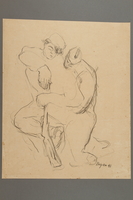
Drawing by Alexander Bogen of two partisans sleeping, one leaning on a rifle
Object
Sketch created by Alexander Bogen while he was a partisan fighter in the Naroch Forest in Belarussia during World War II. The sketch depicts two of his fellow partisans. Bogen was an art student in Vilna in 1941 when Germany invaded and occupied Lithuania and neighboring countries. In the Vilna ghetto, he sketched scenes of the life of his fellow Jews interned there by the Germans. “An artist doomed to death,” he said in later years, “recording and so preserving those doomed to death.” In 1943, he escaped the ghetto and joined the partisans, who carried out sabotage and other actions against the occupying German military. He helped lead the all-Jewish Nekama (Revenge) partisan brigade, and reentered the Vilna ghetto to help underground fighters escape as it was being liquidated by the Germans. When Lithuania was liberated in 1944 by Soviet forces, he returned to Vilna and resumed his studies.
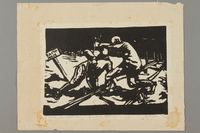
Woodcut by Alexander Bogen of two partisans standing on a railroad track, working with a crowbar, near a sign that says “To Minsk.”
Object
Woodcut created by Alexander Bogen while he was a partisan fighter in the Naroch Forest in Belarussia during World War II. The woodcut depicts two of his fellow partisans sabotaging a railroad track. Bogen was an art student in Vilna in 1941 when Germany invaded and occupied Lithuania and neighboring countries. In the Vilna ghetto, he sketched scenes of the life of his fellow Jews interned there by the Germans. “An artist doomed to death,” he said in later years, “recording and so preserving those doomed to death.” In 1943, he escaped the ghetto and joined the partisans, who carried out sabotage and other actions against the occupying German military. He helped lead the all-Jewish Nekama (Revenge) partisan brigade, and reentered the Vilna ghetto to help underground fighters escape as it was being liquidated by the Germans. When Lithuania was liberated in 1944 by Soviet forces, he returned to Vilna and resumed his studies.
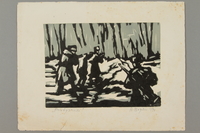
Woodcut by Alexander Bogen of two armed partisans marching in line with an unarmed man between them
Object
Woodcut created by Alexander Bogen while he was a partisan fighter in the Naroch Forest in Belarussia during World War II. Bogen was an art student in Vilna in 1941 when Germany invaded and occupied Lithuania and neighboring countries. In the Vilna ghetto, he sketched scenes of the life of his fellow Jews interned there by the Germans. “An artist doomed to death,” he said in later years, “recording and so preserving those doomed to death.” In 1943, he escaped the ghetto and joined the partisans, who carried out sabotage and other actions against the occupying German military. He helped lead the all-Jewish Nekama (Revenge) partisan brigade, and reentered the Vilna ghetto to help underground fighters escape as it was being liquidated by the Germans. When Lithuania was liberated in 1944 by Soviet forces, he returned to Vilna and resumed his studies.
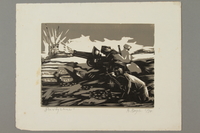
Woodcut by Alexander Bogen of three partisans firing a cannon
Object
Woodcut created by Alexander Bogen while he was a partisan fighter in the Naroch Forest in Belarussia during World War II. The woodcut depicts a group of his fellow partisans in battle. Bogen was an art student in Vilna in 1941 when Germany invaded and occupied Lithuania and neighboring countries. In the Vilna ghetto, he sketched scenes of the life of his fellow Jews interned there by the Germans. “An artist doomed to death,” he said in later years, “recording and so preserving those doomed to death.” In 1943, he escaped the ghetto and joined the partisans, who carried out sabotage and other actions against the occupying German military. He helped lead the all-Jewish Nekama (Revenge) partisan brigade, and reentered the Vilna ghetto to help underground fighters escape as it was being liquidated by the Germans. When Lithuania was liberated in 1944 by Soviet forces, he returned to Vilna and resumed his studies.
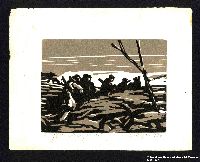
Woodcut by Alexander Bogen of five armed partisans walking in single file through rough terrain
Object
Woodcut created by Alexander Bogen while he was a partisan fighter in the Naroch Forest in Belarussia during World War II. The woodcut depicts a group of his fellow partisans. Bogen was an art student in Vilna in 1941 when Germany invaded and occupied Lithuania and neighboring countries. In the Vilna ghetto, he sketched scenes of the life of his fellow Jews interned there by the Germans. “An artist doomed to death,” he said in later years, “recording and so preserving those doomed to death.” In 1943, he escaped the ghetto and joined the partisans, who carried out sabotage and other actions against the occupying German military. He helped lead the all-Jewish Nekama (Revenge) partisan brigade, and reentered the Vilna ghetto to help underground fighters escape as it was being liquidated by the Germans. When Lithuania was liberated in 1944 by Soviet forces, he returned to Vilna and resumed his studies.

Drawing by Alexander Bogen of a partisan digging with a shovel while two more partisans watch
Object
Sketch created by Alexander Bogen while he was a partisan fighter in the Naroch Forest in Belarussia during World War II. The sketch depicts a group of his fellow partisans. Bogen was an art student in Vilna in 1941 when Germany invaded and occupied Lithuania and neighboring countries. In the Vilna ghetto, he sketched scenes of the life of his fellow Jews interned there by the Germans. “An artist doomed to death,” he said in later years, “recording and so preserving those doomed to death.” In 1943, he escaped the ghetto and joined the partisans, who carried out sabotage and other actions against the occupying German military. He helped lead the all-Jewish Nekama (Revenge) partisan brigade, and reentered the Vilna ghetto to help underground fighters escape as it was being liquidated by the Germans. When Lithuania was liberated in 1944 by Soviet forces, he returned to Vilna and resumed his studies.

Drawing by Alexander Bogen of a partisan wearing heavy winter clothes and a hat with a five-pointed star, pointing a machine gun
Object
Sketch created by Alexander Bogen while he was a partisan fighter in the Naroch Forest in Belarussia during World War II. Bogen was an art student in Vilna in 1941 when Germany invaded and occupied Lithuania and neighboring countries. In the Vilna ghetto, he sketched scenes of the life of his fellow Jews interned there by the Germans. “An artist doomed to death,” he said in later years, “recording and so preserving those doomed to death.” In 1943, he escaped the ghetto and joined the partisans, who carried out sabotage and other actions against the occupying German military. He helped lead the all-Jewish Nekama (Revenge) partisan brigade, and reentered the Vilna ghetto to help underground fighters escape as it was being liquidated by the Germans. When Lithuania was liberated in 1944 by Soviet forces, he returned to Vilna and resumed his studies.
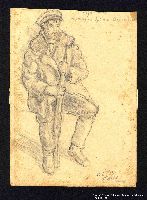
Drawing by Alexander Bogen of a partisan sitting with a rifle between his knees
Object
Sketch created by Alexander Bogen while he was a partisan fighter in the Naroch Forest in Belarussia during World War II. Bogen was an art student in Vilna in 1941 when Germany invaded and occupied Lithuania and neighboring countries. In the Vilna ghetto, he sketched scenes of the life of his fellow Jews interned there by the Germans. “An artist doomed to death,” he said in later years, “recording and so preserving those doomed to death.” In 1943, he escaped the ghetto and joined the partisans, who carried out sabotage and other actions against the occupying German military. He helped lead the all-Jewish Nekama (Revenge) partisan brigade, and reentered the Vilna ghetto to help underground fighters escape as it was being liquidated by the Germans. When Lithuania was liberated in 1944 by Soviet forces, he returned to Vilna and resumed his studies.
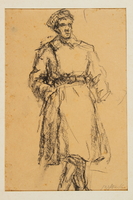
Drawing by Alexander Bogen of a partisan standing with his hands in his pockets
Object
Sketch created by Alexander Bogen while he was a partisan fighter in the Naroch Forest in Belarussia during World War II. Bogen was an art student in Vilna in 1941 when Germany invaded and occupied Lithuania and neighboring countries. In the Vilna ghetto, he sketched scenes of the life of his fellow Jews interned there by the Germans. “An artist doomed to death,” he said in later years, “recording and so preserving those doomed to death.” In 1943, he escaped the ghetto and joined the partisans, who carried out sabotage and other actions against the occupying German military. He helped lead the all-Jewish Nekama (Revenge) partisan brigade, and reentered the Vilna ghetto to help underground fighters escape as it was being liquidated by the Germans. When Lithuania was liberated in 1944 by Soviet forces, he returned to Vilna and resumed his studies.
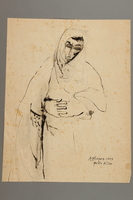
Drawing by Alexander Bogen of a woman in a cloak with her head bowed and her hands clasped in front of her
Object
Sketch created by Alexander Bogen, depicting a woman interned in the ghetto in Vilna, Lithuania. Bogen was an art student in Vilna in 1941 when Germany invaded and occupied Lithuania and neighboring countries. In the Vilna ghetto, he sketched scenes of the life of his fellow Jews interned there by the Germans. “An artist doomed to death,” he said in later years, “recording and so preserving those doomed to death.” In 1943, he escaped the ghetto and joined the partisans in the Naroch Forest in Belarussia, who carried out sabotage and other actions against the occupying German military. He helped lead the all-Jewish Nekama (Revenge) partisan brigade, and reentered the Vilna ghetto to help underground fighters escape as it was being liquidated by the Germans. When Lithuania was liberated in 1944 by Soviet forces, he returned to Vilna and resumed his studies.
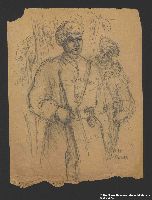
Drawing by Alexander Bogen of two partisans standing in uniform
Object
Sketch created by Alexander Bogen while he was a partisan fighter in the Naroch Forest in Belarussia during World War II. Bogen was an art student in Vilna in 1941 when Germany invaded and occupied Lithuania and neighboring countries. In the Vilna ghetto, he sketched scenes of the life of his fellow Jews interned there by the Germans. “An artist doomed to death,” he said in later years, “recording and so preserving those doomed to death.” In 1943, he escaped the ghetto and joined the partisans, who carried out sabotage and other actions against the occupying German military. He helped lead the all-Jewish Nekama (Revenge) partisan brigade, and reentered the Vilna ghetto to help underground fighters escape as it was being liquidated by the Germans. When Lithuania was liberated in 1944 by Soviet forces, he returned to Vilna and resumed his studies.
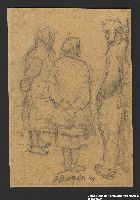
Drawing by Alexander Bogen of an armed partisan talking with two bare-footed women
Object
Sketch created by Alexander Bogen while he was a partisan fighter in the Naroch Forest in Belarussia during World War II. The sketch depicts a group of his fellow partisans. Bogen was an art student in Vilna in 1941 when Germany invaded and occupied Lithuania and neighboring countries. In the Vilna ghetto, he sketched scenes of the life of his fellow Jews interned there by the Germans. “An artist doomed to death,” he said in later years, “recording and so preserving those doomed to death.” In 1943, he escaped the ghetto and joined the partisans, who carried out sabotage and other actions against the occupying German military. He helped lead the all-Jewish Nekama (Revenge) partisan brigade, and reentered the Vilna ghetto to help underground fighters escape as it was being liquidated by the Germans. When Lithuania was liberated in 1944 by Soviet forces, he returned to Vilna and resumed his studies.
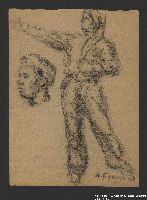
Drawing by Alexander Bogen of a partisan standing with his right arm extended
Object
Sketch created by Alexander Bogen while he was a partisan fighter in the Naroch Forest in Belarussia during World War II. The sketch depicts one of his fellow partisans. Bogen was an art student in Vilna in 1941 when Germany invaded and occupied Lithuania and neighboring countries. In the Vilna ghetto, he sketched scenes of the life of his fellow Jews interned there by the Germans. “An artist doomed to death,” he said in later years, “recording and so preserving those doomed to death.” In 1943, he escaped the ghetto and joined the partisans, who carried out sabotage and other actions against the occupying German military. He helped lead the all-Jewish Nekama (Revenge) partisan brigade, and reentered the Vilna ghetto to help underground fighters escape as it was being liquidated by the Germans. When Lithuania was liberated in 1944 by Soviet forces, he returned to Vilna and resumed his studies.
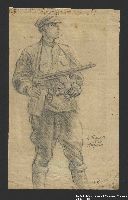
Drawing by Alexander Bogen of a partisan holding a machine gun and carrying two hand grenades on his belt
Object
Sketch created by Alexander Bogen while he was a partisan fighter in the Naroch Forest in Belarussia during World War II. Bogen was an art student in Vilna in 1941 when Germany invaded and occupied Lithuania and neighboring countries. In the Vilna ghetto, he sketched scenes of the life of his fellow Jews interned there by the Germans. “An artist doomed to death,” he said in later years, “recording and so preserving those doomed to death.” In 1943, he escaped the ghetto and joined the partisans, who carried out sabotage and other actions against the occupying German military. He helped lead the all-Jewish Nekama (Revenge) partisan brigade, and reentered the Vilna ghetto to help underground fighters escape as it was being liquidated by the Germans. When Lithuania was liberated in 1944 by Soviet forces, he returned to Vilna and resumed his studies.
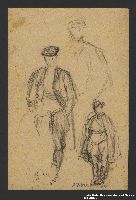
Studies of a man wearing a cloak and high boots, drawn by Alexander Bogen
Object
Sketch created by Alexander Bogen while he was a partisan fighter in the Naroch Forest in Belarussia during World War II. Bogen was an art student in Vilna in 1941 when Germany invaded and occupied Lithuania and neighboring countries. In the Vilna ghetto, he sketched scenes of the life of his fellow Jews interned there by the Germans. “An artist doomed to death,” he said in later years, “recording and so preserving those doomed to death.” In 1943, he escaped the ghetto and joined the partisans, who carried out sabotage and other actions against the occupying German military. He helped lead the all-Jewish Nekama (Revenge) partisan brigade, and reentered the Vilna ghetto to help underground fighters escape as it was being liquidated by the Germans. When Lithuania was liberated in 1944 by Soviet forces, he returned to Vilna and resumed his studies.
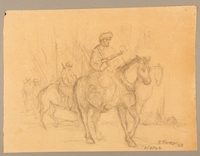
Partisans in the woods, including two armed men riding horses, drawn by Alexander Bogen
Object
Sketch created by Alexander Bogen while he was a partisan fighter in the Naroch Forest in Belarussia during World War II. Bogen was an art student in Vilna in 1941 when Germany invaded and occupied Lithuania and neighboring countries. In the Vilna ghetto, he sketched scenes of the life of his fellow Jews interned there by the Germans. “An artist doomed to death,” he said in later years, “recording and so preserving those doomed to death.” In 1943, he escaped the ghetto and joined the partisans, who carried out sabotage and other actions against the occupying German military. He helped lead the all-Jewish Nekama (Revenge) partisan brigade, and reentered the Vilna ghetto to help underground fighters escape as it was being liquidated by the Germans. When Lithuania was liberated in 1944 by Soviet forces, he returned to Vilna and resumed his studies.
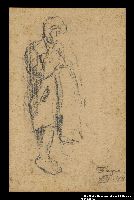
Drawing by Alexander Bogen of a child bundled in thick clothing
Object
Sketch created by Alexander Bogen, depicting a child bundled in winter clothing. Bogen was an art student in Vilna in 1941 when Germany invaded and occupied Lithuania and neighboring countries. In the Vilna ghetto, he sketched scenes of the life of his fellow Jews interned there by the Germans. “An artist doomed to death,” he said in later years, “recording and so preserving those doomed to death.” In 1943, he escaped the ghetto and joined the partisans in the Naroch Forest in Belarussia, who carried out sabotage and other actions against the occupying German military. He helped lead the all-Jewish Nekama (Revenge) partisan brigade, and reentered the Vilna ghetto to help underground fighters escape as it was being liquidated by the Germans. When Lithuania was liberated in 1944 by Soviet forces, he returned to Vilna and resumed his studies.
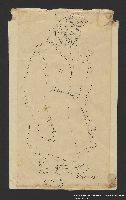
Drawing by Alexander Bogen of a man in heavy winter clothes with a star on his chest
Object
Sketch created by Alexander Bogen, depicting a man in winter clothing with a star on his chest. Bogen was an art student in Vilna in 1941 when Germany invaded and occupied Lithuania and neighboring countries. In the Vilna ghetto, he sketched scenes of the life of his fellow Jews interned there by the Germans. “An artist doomed to death,” he said in later years, “recording and so preserving those doomed to death.” In 1943, he escaped the ghetto and joined the partisans in the Naroch Forest in Belarussia, who carried out sabotage and other actions against the occupying German military. He helped lead the all-Jewish Nekama (Revenge) partisan brigade, and reentered the Vilna ghetto to help underground fighters escape as it was being liquidated by the Germans. When Lithuania was liberated in 1944 by Soviet forces, he returned to Vilna and resumed his studies.
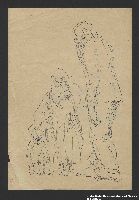
Two studies by Alexander Bogen, one of an old, bearded man walking, one of a woman with a baby in her arms, walking with a small child
Object
Sketch created by Alexander Bogen, depicting a group of Jews interned in the ghetto in Vilna, Lithuania. Bogen was an art student in Vilna in 1941 when Germany invaded and occupied Lithuania and neighboring countries. In the Vilna ghetto, he sketched scenes of the life of his fellow Jews interned there by the Germans. “An artist doomed to death,” he said in later years, “recording and so preserving those doomed to death.” In 1943, he escaped the ghetto and joined the partisans in the Naroch Forest in Belarussia, who carried out sabotage and other actions against the occupying German military. He helped lead the all-Jewish Nekama (Revenge) partisan brigade, and reentered the Vilna ghetto to help underground fighters escape as it was being liquidated by the Germans. When Lithuania was liberated in 1944 by Soviet forces, he returned to Vilna and resumed his studies.

Drawing by Alexander Bogen of a horse pulling a sledge past woods with an armed man standing among the trees
Object
Sketch created by Alexander Bogen while he was a partisan fighter in the Naroch Forest in Belarussia during World War II. Bogen was an art student in Vilna in 1941 when Germany invaded and occupied Lithuania and neighboring countries. In the Vilna ghetto, he sketched scenes of the life of his fellow Jews interned there by the Germans. “An artist doomed to death,” he said in later years, “recording and so preserving those doomed to death.” In 1943, he escaped the ghetto and joined the partisans, who carried out sabotage and other actions against the occupying German military. He helped lead the all-Jewish Nekama (Revenge) partisan brigade, and reentered the Vilna ghetto to help underground fighters escape as it was being liquidated by the Germans. When Lithuania was liberated in 1944 by Soviet forces, he returned to Vilna and resumed his studies.

Drawing by Alexander Bogen of a man on the ground, propping himself up on his right arm, his eyes and mouth open wide
Object
Sketch created by Alexander Bogen while he was a partisan fighter in the Naroch Forest in Belarussia during World War II. Bogen was an art student in Vilna in 1941 when Germany invaded and occupied Lithuania and neighboring countries. In the Vilna ghetto, he sketched scenes of the life of his fellow Jews interned there by the Germans. “An artist doomed to death,” he said in later years, “recording and so preserving those doomed to death.” In 1943, he escaped the ghetto and joined the partisans, who carried out sabotage and other actions against the occupying German military. He helped lead the all-Jewish Nekama (Revenge) partisan brigade, and reentered the Vilna ghetto to help underground fighters escape as it was being liquidated by the Germans. When Lithuania was liberated in 1944 by Soviet forces, he returned to Vilna and resumed his studies.
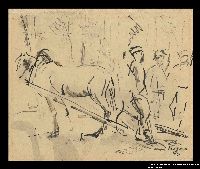
Drawing by Alexander Bogen of three armed partisans standing by a horse in harness
Object
Sketch created by Alexander Bogen while he was a partisan fighter in the Naroch Forest in Belarussia during World War II. The sketch depicts a group of his fellow partisans. Bogen was an art student in Vilna in 1941 when Germany invaded and occupied Lithuania and neighboring countries. In the Vilna ghetto, he sketched scenes of the life of his fellow Jews interned there by the Germans. “An artist doomed to death,” he said in later years, “recording and so preserving those doomed to death.” In 1943, he escaped the ghetto and joined the partisans, who carried out sabotage and other actions against the occupying German military. He was a member of the all-Jewish Nekama (Revenge) partisan brigade, and reentered the Vilna ghetto to help underground fighters escape as it was being liquidated by the Germans. When Lithuania was liberated in 1944 by Soviet forces, he returned to Vilna and resumed his studies.

Drawing by Alexander Bogen of a German soldier and officer herding an old man, a barefoot woman with a baby in her arms, and a barefoot child at gunpoint
Object
Sketch created by Alexander Bogen, depicting a German soldier and a German officer rounding up a group of Jews in the ghetto of Vilna, Lithuania. Bogen was an art student in Vilna in 1941 when Germany invaded and occupied Lithuania and neighboring countries. In the Vilna ghetto, he sketched scenes of the life of his fellow Jews interned there by the Germans. “An artist doomed to death,” he said in later years, “recording and so preserving those doomed to death.” In 1943, he escaped the ghetto and joined the partisans in the Naroch Forest in Belarussia, who carried out sabotage and other actions against the occupying German military. He helped lead the all-Jewish Nekama (Revenge) partisan brigade, and reentered the Vilna ghetto to help underground fighters escape as it was being liquidated by the Germans. When Lithuania was liberated in 1944 by Soviet forces, he returned to Vilna and resumed his studies.
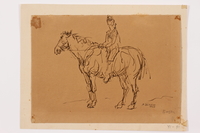
Drawing by Alexander Bogen of an armed partisan sitting on a horse
Object
Sketch created by Alexander Bogen while he was a partisan fighter in the Naroch Forest in Belarussia during World War II. Bogen was an art student in Vilna in 1941 when Germany invaded and occupied Lithuania and neighboring countries. In the Vilna ghetto, he sketched scenes of the life of his fellow Jews interned there by the Germans. “An artist doomed to death,” he said in later years, “recording and so preserving those doomed to death.” In 1943, he escaped the ghetto and joined the partisans, who carried out sabotage and other actions against the occupying German military. He helped lead the all-Jewish Nekama (Revenge) partisan brigade, and reentered the Vilna ghetto to help underground fighters escape as it was being liquidated by the Germans. When Lithuania was liberated in 1944 by Soviet forces, he returned to Vilna and resumed his studies.
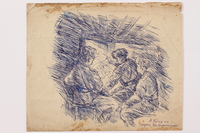
Drawing by Alexander Bogen of three partisans in a bunker looking at a map
Object
Sketch created by Alexander Bogen while he was a partisan fighter in the Naroch Forest in Belarussia during World War II. The sketch depicts a group of his fellow partisans. Bogen was an art student in Vilna in 1941 when Germany invaded and occupied Lithuania and neighboring countries. In the Vilna ghetto, he sketched scenes of the life of his fellow Jews interned there by the Germans. “An artist doomed to death,” he said in later years, “recording and so preserving those doomed to death.” In 1943, he escaped the ghetto and joined the partisans, who carried out sabotage and other actions against the occupying German military. He helped lead the all-Jewish Nekama (Revenge) partisan brigade, and reentered the Vilna ghetto to help underground fighters escape as it was being liquidated by the Germans. When Lithuania was liberated in 1944 by Soviet forces, he returned to Vilna and resumed his studies.
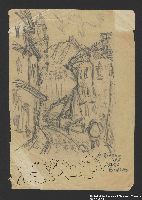
Drawing by Alexander Bogen of a curving, cobblestone street with buildings on either side, a person walking along the sidewalk, and a large building with a tower in the background
Object
Sketch created by Alexander Bogen, depicting a street scene in the ghetto in Vilna, Lithuania. Bogen was an art student in Vilna in 1941 when Germany invaded and occupied Lithuania and neighboring countries. In the Vilna ghetto, he sketched scenes of the life of his fellow Jews interned there by the Germans. “An artist doomed to death,” he said in later years, “recording and so preserving those doomed to death.” In 1943, he escaped the ghetto and joined the partisans in the Naroch Forest in Belarussia, who carried out sabotage and other actions against the occupying German military. He helped lead the all-Jewish Nekama (Revenge) partisan brigade, and reentered the Vilna ghetto to help underground fighters escape as it was being liquidated by the Germans. When Lithuania was liberated in 1944 by Soviet forces, he returned to Vilna and resumed his studies.
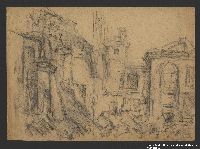
Drawing by Alexander Bogen of rubble and damaged buildings
Object
Sketch created by Alexander Bogen, depicting a scene of destruction during the liquidation of the ghetto in Vilna, Lithuania. Bogen was an art student in Vilna in 1941 when Germany invaded and occupied Lithuania and neighboring countries. In the Vilna ghetto, he sketched scenes of the life of his fellow Jews interned there by the Germans. “An artist doomed to death,” he said in later years, “recording and so preserving those doomed to death.” In 1943, he escaped the ghetto and joined the partisans in the Naroch Forest in Belarussia, who carried out sabotage and other actions against the occupying German military. He helped lead the all-Jewish Nekama (Revenge) partisan brigade, and reentered the Vilna ghetto to help underground fighters escape as it was being liquidated by the Germans. When Lithuania was liberated in 1944 by Soviet forces, he returned to Vilna and resumed his studies.

Drawing by Alexander Bogen of a woman in a head scarf and a child in a cap standing side by side
Object
Sketch created by Alexander Bogen, depicting two Jews interned in the ghetto of Vilna, Lithuania. Bogen was an art student in Vilna in 1941 when Germany invaded and occupied Lithuania and neighboring countries. In the Vilna ghetto, he sketched scenes of the life of his fellow Jews interned there by the Germans. “An artist doomed to death,” he said in later years, “recording and so preserving those doomed to death.” In 1943, he escaped the ghetto and joined the partisans in the Naroch Forest in Belarussia, who carried out sabotage and other actions against the occupying German military. He helped lead the all-Jewish Nekama (Revenge) partisan brigade, and reentered the Vilna ghetto to help underground fighters escape as it was being liquidated by the Germans. When Lithuania was liberated in 1944 by Soviet forces, he returned to Vilna and resumed his studies.
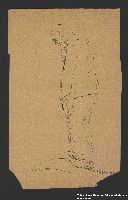
Drawing by Alexander Bogen of a stooped, bearded man walking
Object
Sketch created by Alexander Bogen, depicting an old man. Bogen was an art student in Vilna in 1941 when Germany invaded and occupied Lithuania and neighboring countries. In the Vilna ghetto, he sketched scenes of the life of his fellow Jews interned there by the Germans. “An artist doomed to death,” he said in later years, “recording and so preserving those doomed to death.” In 1943, he escaped the ghetto and joined the partisans in the Naroch Forest in Belarussia, who carried out sabotage and other actions against the occupying German military. He helped lead the all-Jewish Nekama (Revenge) partisan brigade, and reentered the Vilna ghetto to help underground fighters escape as it was being liquidated by the Germans. When Lithuania was liberated in 1944 by Soviet forces, he returned to Vilna and resumed his studies.
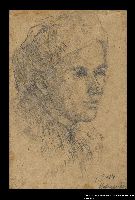
Portrait of a partisan in a winter hat, drawn by Alexander Bogen
Object
Sketch created by Alexander Bogen while he was a partisan fighter in the Naroch Forest in Belarussia during World War II. Bogen was an art student in Vilna in 1941 when Germany invaded and occupied Lithuania and neighboring countries. In the Vilna ghetto, he sketched scenes of the life of his fellow Jews interned there by the Germans. “An artist doomed to death,” he said in later years, “recording and so preserving those doomed to death.” In 1943, he escaped the ghetto and joined the partisans, who carried out sabotage and other actions against the occupying German military. He helped lead the all-Jewish Nekama (Revenge) partisan brigade, and reentered the Vilna ghetto to help underground fighters escape as it was being liquidated by the Germans. When Lithuania was liberated in 1944 by Soviet forces, he returned to Vilna and resumed his studies.
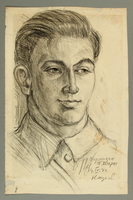
Portrait of a Jewish Lithuanian partisan, drawn by Alexander Bogen
Object
Sketch of Tuvia Szeres, a 24 year old partisan fighter known as Tevko the Tiger, created by Alexander Bogen while he was a partisan fighter in the Naroch Forest in Belarussia during World War II. Bogen was an art student in Vilna (Vilnius) in June1941 when Germany occupied Lithuania. In the Vilna ghetto, he sketched scenes of the life of his fellow Jews interned there by the Germans. “An artist doomed to death,” he said in later years, “recording and so preserving those doomed to death.” In 1943, he escaped and joined the partisans, who carried out sabotage and other actions against the occupying German military. He was in the all-Jewish Nekama (Revenge) partisan brigade, and reentered Vilna ghetto to help underground fighters escape as it was being liquidated by the Germans in September 1943. When Lithuania was liberated in summer 1944 by Soviet forces, he returned to Vilna and resumed his studies. Tuvia was also interned in Vilna ghetto, escaping in 1943 to join the partisans. He was with the Chapaev Unit. After the war ended in May 1945, Tuvia did aid work in Italy, helping displaced persons with the American Jewish Joint Distribution Committee and assisting Bricha, which helped survivors illegally emigrate to Palestine.
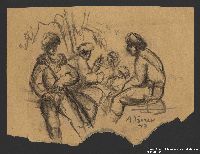
Drawing by Alexander Bogen of five partisans sitting by a tree
Object
Sketch created by Alexander Bogen while he was a partisan fighter in the Naroch Forest in Belarussia during World War II. The sketch depicts a group of his fellow partisans. Bogen was an art student in Vilna in 1941 when Germany invaded and occupied Lithuania and neighboring countries. In the Vilna ghetto, he sketched scenes of the life of his fellow Jews interned there by the Germans. “An artist doomed to death,” he said in later years, “recording and so preserving those doomed to death.” In 1943, he escaped the ghetto and joined the partisans, who carried out sabotage and other actions against the occupying German military. He helped lead the all-Jewish Nekama (Revenge) partisan brigade, and reentered the Vilna ghetto to help underground fighters escape as it was being liquidated by the Germans. When Lithuania was liberated in 1944 by Soviet forces, he returned to Vilna and resumed his studies.
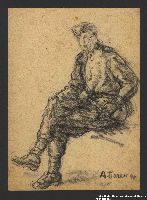
Seated portrait of a partisan in uniform, drawn by Alexander Bogen
Object
Sketch created by Alexander Bogen while he was a partisan fighter in the Naroch Forest in Belarussia during World War II. Bogen was an art student in Vilna in 1941 when Germany invaded and occupied Lithuania and neighboring countries. In the Vilna ghetto, he sketched scenes of the life of his fellow Jews interned there by the Germans. “An artist doomed to death,” he said in later years, “recording and so preserving those doomed to death.” In 1943, he escaped the ghetto and joined the partisans, who carried out sabotage and other actions against the occupying German military. He helped lead the all-Jewish Nekama (Revenge) partisan brigade, and reentered the Vilna ghetto to help underground fighters escape as it was being liquidated by the Germans. When Lithuania was liberated in 1944 by Soviet forces, he returned to Vilna and resumed his studies.

Drawing by Alexander Bogen of a man sitting at a table reading a book
Object
Sketch created by Alexander Bogen while he was a partisan fighter in the Naroch Forest in Belarussia during World War II. Bogen was an art student in Vilna in 1941 when Germany invaded and occupied Lithuania and neighboring countries. In the Vilna ghetto, he sketched scenes of the life of his fellow Jews interned there by the Germans. “An artist doomed to death,” he said in later years, “recording and so preserving those doomed to death.” In 1943, he escaped the ghetto and joined the partisans, who carried out sabotage and other actions against the occupying German military. He helped lead the all-Jewish Nekama (Revenge) partisan brigade, and reentered the Vilna ghetto to help underground fighters escape as it was being liquidated by the Germans. When Lithuania was liberated in 1944 by Soviet forces, he returned to Vilna and resumed his studies.
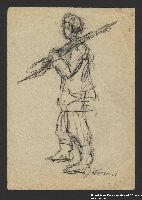
Drawing by Alexander Bogen of a partisan walking with a rifle on his shoulder
Object
Sketch created by Alexander Bogen while he was a partisan fighter in the Naroch Forest in Belarussia during World War II. Bogen was an art student in Vilna in 1941 when Germany invaded and occupied Lithuania and neighboring countries. In the Vilna ghetto, he sketched scenes of the life of his fellow Jews interned there by the Germans. “An artist doomed to death,” he said in later years, “recording and so preserving those doomed to death.” In 1943, he escaped the ghetto and joined the partisans, who carried out sabotage and other actions against the occupying German military. He helped lead the all-Jewish Nekama (Revenge) partisan brigade, and reentered the Vilna ghetto to help underground fighters escape as it was being liquidated by the Germans. When Lithuania was liberated in 1944 by Soviet forces, he returned to Vilna and resumed his studies.

Drawing by Alexander Bogen of two partisans standing together, one lighting the other’s cigarette
Object
Sketch created by Alexander Bogen while he was a partisan fighter in the Naroch Forest in Belarussia during World War II. The sketch depicts two of his fellow partisans. Bogen was an art student in Vilna in 1941 when Germany invaded and occupied Lithuania and neighboring countries. In the Vilna ghetto, he sketched scenes of the life of his fellow Jews interned there by the Germans. “An artist doomed to death,” he said in later years, “recording and so preserving those doomed to death.” In 1943, he escaped the ghetto and joined the partisans, who carried out sabotage and other actions against the occupying German military. He helped lead the all-Jewish Nekama (Revenge) partisan brigade, and reentered the Vilna ghetto to help underground fighters escape as it was being liquidated by the Germans. When Lithuania was liberated in 1944 by Soviet forces, he returned to Vilna and resumed his studies.
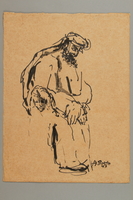
Drawing by Alexander Bogen of a woman and a bearded man
Object
Sketch created by Alexander Bogen, depicting people interned in the ghetto of Vilna, Lithuania. Bogen was an art student in Vilna in 1941 when Germany invaded and occupied Lithuania and neighboring countries. In the Vilna ghetto, he sketched scenes of the life of his fellow Jews interned there by the Germans. “An artist doomed to death,” he said in later years, “recording and so preserving those doomed to death.” In 1943, he escaped the ghetto and joined the partisans in the Naroch Forest in Belarussia, who carried out sabotage and other actions against the occupying German military. He helped lead the all-Jewish Nekama (Revenge) partisan brigade, and reentered the Vilna ghetto to help underground fighters escape as it was being liquidated by the Germans. When Lithuania was liberated in 1944 by Soviet forces, he returned to Vilna and resumed his studies.

Studies of an old man with a beard, drawn by Alexander Bogen
Object
Sketch created by Alexander Bogen, depicting an old Jewish man interned in the ghetto of Vilna, Lithuania. Bogen was an art student in Vilna in 1941 when Germany invaded and occupied Lithuania and neighboring countries. In the Vilna ghetto, he sketched scenes of the life of his fellow Jews interned there by the Germans. “An artist doomed to death,” he said in later years, “recording and so preserving those doomed to death.” In 1943, he escaped the ghetto and joined the partisans in the Naroch Forest in Belarussia, who carried out sabotage and other actions against the occupying German military. He helped lead the all-Jewish Nekama (Revenge) partisan brigade, and reentered the Vilna ghetto to help underground fighters escape as it was being liquidated by the Germans. When Lithuania was liberated in 1944 by Soviet forces, he returned to Vilna and resumed his studies
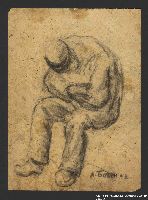
Drawing by Alexander Bogen of a man sitting with his head bowed
Object
Sketch created by Alexander Bogen, depicting a Jewish man interned in the ghetto of Vilna, Lithuania. Bogen was an art student in Vilna in 1941 when Germany invaded and occupied Lithuania and neighboring countries. In the Vilna ghetto, he sketched scenes of the life of his fellow Jews interned there by the Germans. “An artist doomed to death,” he said in later years, “recording and so preserving those doomed to death.” In 1943, he escaped the ghetto and joined the partisans in the Naroch Forest in Belarussia, who carried out sabotage and other actions against the occupying German military. He helped lead the all-Jewish Nekama (Revenge) partisan brigade, and reentered the Vilna ghetto to help underground fighters escape as it was being liquidated by the Germans. When Lithuania was liberated in 1944 by Soviet forces, he returned to Vilna and resumed his studies.
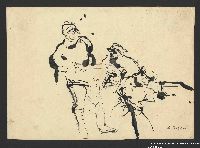
Drawing by Alexander Bogen of two partisans, one standing and one crouching
Object
Sketch created by Alexander Bogen while he was a partisan fighter in the Naroch Forest in Belarussia during World War II. The sketch depicts two of his fellow partisans. Bogen was an art student in Vilna in 1941 when Germany invaded and occupied Lithuania and neighboring countries. In the Vilna ghetto, he sketched scenes of the life of his fellow Jews interned there by the Germans. “An artist doomed to death,” he said in later years, “recording and so preserving those doomed to death.” In 1943, he escaped the ghetto and joined the partisans, who carried out sabotage and other actions against the occupying German military. He helped lead the all-Jewish Nekama (Revenge) partisan brigade, and reentered the Vilna ghetto to help underground fighters escape as it was being liquidated by the Germans. When Lithuania was liberated in 1944 by Soviet forces, he returned to Vilna and resumed his studies
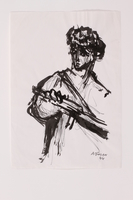
Drawing by Alexander Bogen of a partisan with a rifle
Object
Sketch created by Alexander Bogen while he was a partisan fighter in the Naroch Forest in Belarussia during World War II. Bogen was an art student in Vilna in 1941 when Germany invaded and occupied Lithuania and neighboring countries. In the Vilna ghetto, he sketched scenes of the life of his fellow Jews interned there by the Germans. “An artist doomed to death,” he said in later years, “recording and so preserving those doomed to death.” In 1943, he escaped the ghetto and joined the partisans, who carried out sabotage and other actions against the occupying German military. He helped lead the all-Jewish Nekama (Revenge) partisan brigade, and reentered the Vilna ghetto to help underground fighters escape as it was being liquidated by the Germans. When Lithuania was liberated in 1944 by Soviet forces, he returned to Vilna and resumed his studies.
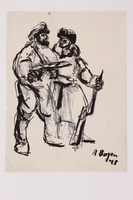
Drawing by Alexander Bogen of two armed partisans standing together
Object
Sketch created by Alexander Bogen while he was a partisan fighter in the Naroch Forest in Belarussia during World War II. Bogen was an art student in Vilna in 1941 when Germany invaded and occupied Lithuania and neighboring countries. In the Vilna ghetto, he sketched scenes of the life of his fellow Jews interned there by the Germans. “An artist doomed to death,” he said in later years, “recording and so preserving those doomed to death.” In 1943, he escaped the ghetto and joined the partisans, who carried out sabotage and other actions against the occupying German military. He helped lead the all-Jewish Nekama (Revenge) partisan brigade, and reentered the Vilna ghetto to help underground fighters escape as it was being liquidated by the Germans. When Lithuania was liberated in 1944 by Soviet forces, he returned to Vilna and resumed his studies.
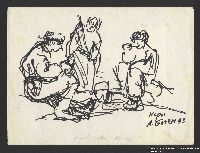
Drawing by Alexander Bogen of three partisans eating around a camp stove
Object
Sketch created by Alexander Bogen while he was a partisan fighter in the Naroch Forest in Belarussia during World War II. The sketch depicts a group of his fellow partisans. Bogen was an art student in Vilna in 1941 when Germany invaded and occupied Lithuania and neighboring countries. In the Vilna ghetto, he sketched scenes of the life of his fellow Jews interned there by the Germans. “An artist doomed to death,” he said in later years, “recording and so preserving those doomed to death.” In 1943, he escaped the ghetto and joined the partisans, who carried out sabotage and other actions against the occupying German military. He helped lead the all-Jewish Nekama (Revenge) partisan brigade, and reentered the Vilna ghetto to help underground fighters escape as it was being liquidated by the Germans. When Lithuania was liberated in 1944 by Soviet forces, he returned to Vilna and resumed his studies.

Drawing by Alexander Bogen of a partisan standing with a rifle
Object
Sketch created by Alexander Bogen while he was a partisan fighter in the Naroch Forest in Belarussia during World War II. Bogen was an art student in Vilna in 1941 when Germany invaded and occupied Lithuania and neighboring countries. In the Vilna ghetto, he sketched scenes of the life of his fellow Jews interned there by the Germans. “An artist doomed to death,” he said in later years, “recording and so preserving those doomed to death.” In 1943, he escaped the ghetto and joined the partisans, who carried out sabotage and other actions against the occupying German military. He helped lead the all-Jewish Nekama (Revenge) partisan brigade, and reentered the Vilna ghetto to help underground fighters escape as it was being liquidated by the Germans. When Lithuania was liberated in 1944 by Soviet forces, he returned to Vilna and resumed his studies.
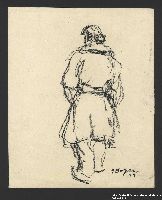
Drawing by Alexander Bogen of a partisan walking
Object
Sketch created by Alexander Bogen while he was a partisan fighter in the Naroch Forest in Belarussia during World War II. Bogen was an art student in Vilna in 1941 when Germany invaded and occupied Lithuania and neighboring countries. In the Vilna ghetto, he sketched scenes of the life of his fellow Jews interned there by the Germans. “An artist doomed to death,” he said in later years, “recording and so preserving those doomed to death.” In 1943, he escaped the ghetto and joined the partisans, who carried out sabotage and other actions against the occupying German military. He helped lead the all-Jewish Nekama (Revenge) partisan brigade, and reentered the Vilna ghetto to help underground fighters escape as it was being liquidated by the Germans. When Lithuania was liberated in 1944 by Soviet forces, he returned to Vilna and resumed his studies.

Drawing by Alexander Bogen of an old man, a woman holding a baby, and a little girl standing before a scene of flames and destroyed buildings
Object
Sketch created by Alexander Bogen, depicting a scene of destruction during the liquidation of the ghetto in Vilna, Lithuania. Bogen was an art student in Vilna in 1941 when Germany invaded and occupied Lithuania and neighboring countries. In the Vilna ghetto, he sketched scenes of the life of his fellow Jews interned there by the Germans. “An artist doomed to death,” he said in later years, “recording and so preserving those doomed to death.” In 1943, he escaped the ghetto and joined the partisans in the Naroch Forest in Belarussia, who carried out sabotage and other actions against the occupying German military. He helped lead the all-Jewish Nekama (Revenge) partisan brigade, and reentered the Vilna ghetto to help underground fighters escape as it was being liquidated by the Germans. When Lithuania was liberated in 1944 by Soviet forces, he returned to Vilna and resumed his studies.
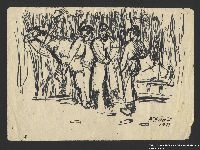
Drawing by Alexander Bogen of three partisans standing by a horse harnessed to a sledge
Object
Sketch created by Alexander Bogen while he was a partisan fighter in the Naroch Forest in Belarussia during World War II. The sketch depicts a group of his fellow partisans. Bogen was an art student in Vilna in 1941 when Germany invaded and occupied Lithuania and neighboring countries. In the Vilna ghetto, he sketched scenes of the life of his fellow Jews interned there by the Germans. “An artist doomed to death,” he said in later years, “recording and so preserving those doomed to death.” In 1943, he escaped the ghetto and joined the partisans, who carried out sabotage and other actions against the occupying German military. He helped lead the all-Jewish Nekama (Revenge) partisan brigade, and reentered the Vilna ghetto to help underground fighters escape as it was being liquidated by the Germans. When Lithuania was liberated in 1944 by Soviet forces, he returned to Vilna and resumed his studies.
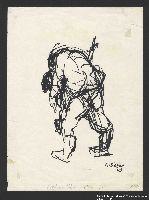
Drawing by Alexander Bogen of a man carrying another man on his back
Object
Sketch created by Alexander Bogen while he was a partisan fighter in the Naroch Forest in Belarussia during World War II. The sketch depicts a partisan carrying an injured comrade. Bogen was an art student in Vilna in 1941 when Germany invaded and occupied Lithuania and neighboring countries. In the Vilna ghetto, he sketched scenes of the life of his fellow Jews interned there by the Germans. “An artist doomed to death,” he said in later years, “recording and so preserving those doomed to death.” In 1943, he escaped the ghetto and joined the partisans, who carried out sabotage and other actions against the occupying German military. He helped lead the all-Jewish Nekama (Revenge) partisan brigade, and reentered the Vilna ghetto to help underground fighters escape as it was being liquidated by the Germans. When Lithuania was liberated in 1944 by Soviet forces, he returned to Vilna and resumed his studies.
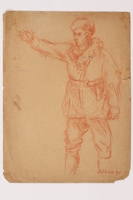
Drawing by Alexander Bogen of a partisan gesturing with his right arm
Object
Sketch created by Alexander Bogen while he was a partisan fighter in the Naroch Forest in Belarussia during World War II. The sketch depicts one of his fellow partisans. Bogen was an art student in Vilna in 1941 when Germany invaded and occupied Lithuania and neighboring countries. In the Vilna ghetto, he sketched scenes of the life of his fellow Jews interned there by the Germans. “An artist doomed to death,” he said in later years, “recording and so preserving those doomed to death.” In 1943, he escaped the ghetto and joined the partisans, who carried out sabotage and other actions against the occupying German military. He helped lead the all-Jewish Nekama (Revenge) partisan brigade, and reentered the Vilna ghetto to help underground fighters escape as it was being liquidated by the Germans. When Lithuania was liberated in 1944 by Soviet forces, he returned to Vilna and resumed his studies.
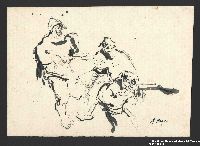
Drawing by Alexander Bogen of three partisans
Object
Sketch created by Alexander Bogen while he was a partisan fighter in the Naroch Forest in Belarussia during World War II. The sketch depicts a group of his fellow partisans in battle. Bogen was an art student in Vilna in 1941 when Germany invaded and occupied Lithuania and neighboring countries. In the Vilna ghetto, he sketched scenes of the life of his fellow Jews interned there by the Germans. “An artist doomed to death,” he said in later years, “recording and so preserving those doomed to death.” In 1943, he escaped the ghetto and joined the partisans, who carried out sabotage and other actions against the occupying German military. He helped lead the all-Jewish Nekama (Revenge) partisan brigade, and reentered the Vilna ghetto to help underground fighters escape as it was being liquidated by the Germans. When Lithuania was liberated in 1944 by Soviet forces, he returned to Vilna and resumed his studies.
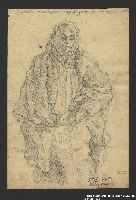
Drawing by Alexander Bogen of an old woman in a shawl standing with her hands folded
Object
Sketch created by Alexander Bogen, depicting an old Jewish woman interned in the ghetto in Vilna, Lithuania. Bogen was an art student in Vilna in 1941 when Germany invaded and occupied Lithuania and neighboring countries. In the Vilna ghetto, he sketched scenes of the life of his fellow Jews interned there by the Germans. “An artist doomed to death,” he said in later years, “recording and so preserving those doomed to death.” In 1943, he escaped the ghetto and joined the partisans in the Naroch Forest in Belarussia, who carried out sabotage and other actions against the occupying German military. He helped lead the all-Jewish Nekama (Revenge) partisan brigade, and reentered the Vilna ghetto to help underground fighters escape as it was being liquidated by the Germans. When Lithuania was liberated in 1944 by Soviet forces, he returned to Vilna and resumed his studies.
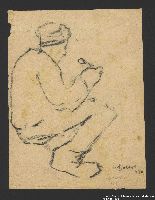
Drawing by Alexander Bogen of a partisan sitting and eating
Object
Sketch created by Alexander Bogen while he was a partisan fighter in the Naroch Forest in Belarussia during World War II. The sketch depicts one of his fellow partisans. Bogen was an art student in Vilna in 1941 when Germany invaded and occupied Lithuania and neighboring countries. In the Vilna ghetto, he sketched scenes of the life of his fellow Jews interned there by the Germans. “An artist doomed to death,” he said in later years, “recording and so preserving those doomed to death.” In 1943, he escaped the ghetto and joined the partisans, who carried out sabotage and other actions against the occupying German military. He helped lead the all-Jewish Nekama (Revenge) partisan brigade, and reentered the Vilna ghetto to help underground fighters escape as it was being liquidated by the Germans. When Lithuania was liberated in 1944 by Soviet forces, he returned to Vilna and resumed his studies.

Drawing by Alexander Bogen of a seated man with a hat
Object
Sketch created by Alexander Bogen, depicting a Jew interned in the ghetto in Vilna, Lithuania. Bogen was an art student in Vilna in 1941 when Germany invaded and occupied Lithuania and neighboring countries. In the Vilna ghetto, he sketched scenes of the life of his fellow Jews interned there by the Germans. “An artist doomed to death,” he said in later years, “recording and so preserving those doomed to death.” In 1943, he escaped the ghetto and joined the partisans in the Naroch Forest in Belarussia, who carried out sabotage and other actions against the occupying German military. He helped lead the all-Jewish Nekama (Revenge) partisan brigade, and reentered the Vilna ghetto to help underground fighters escape as it was being liquidated by the Germans. When Lithuania was liberated in 1944 by Soviet forces, he returned to Vilna and resumed his studies.
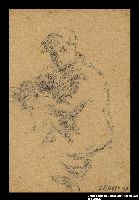
Drawing by Alexander Bogen of a man sitting at a table reading
Object
Sketch created by Alexander Bogen, depicting a Jewish man interned in the ghetto inVilna, Lithuania. Bogen was an art student in Vilna in 1941 when Germany invaded and occupied Lithuania and neighboring countries. In the Vilna ghetto, he sketched scenes of the life of his fellow Jews interned there by the Germans. “An artist doomed to death,” he said in later years, “recording and so preserving those doomed to death.” In 1943, he escaped the ghetto and joined the partisans in the Naroch Forest in Belarussia, who carried out sabotage and other actions against the occupying German military. He helped lead the all-Jewish Nekama (Revenge) partisan brigade, and reentered the Vilna ghetto to help underground fighters escape as it was being liquidated by the Germans. When Lithuania was liberated in 1944 by Soviet forces, he returned to Vilna and resumed his studies.
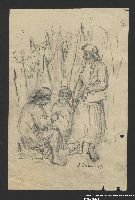
Drawing by Alexander Bogen of a woman sitting outdoors and working with her hands as two women stand and watch
Object
Sketch created by Alexander Bogen while he was a partisan fighter in the Naroch Forest in Belarussia during World War II. The sketch depicts a scene in a camp overseen by the partisans for civilian refugees hiding in the forest. Bogen was an art student in Vilna in 1941 when Germany invaded and occupied Lithuania and neighboring countries. In the Vilna ghetto, he sketched scenes of the life of his fellow Jews interned there by the Germans. “An artist doomed to death,” he said in later years, “recording and so preserving those doomed to death.” In 1943, he escaped the ghetto and joined the partisans, who carried out sabotage and other actions against the occupying German military. He helped lead the all-Jewish Nekama (Revenge) partisan brigade, and reentered the Vilna ghetto to help underground fighters escape as it was being liquidated by the Germans. When Lithuania was liberated in 1944 by Soviet forces, he returned to Vilna and resumed his studies.
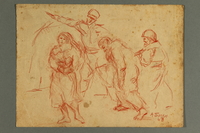
Drawing by Alexander Bogen of a soldier and an officer herding a group of Jews at gunpoint
Object
Sketch created by Alexander Bogen, depicting a German soldier and a German officer rounding up a group of Jews in the ghetto in Vilna, Lithuania. Bogen was an art student in Vilna in 1941 when Germany invaded and occupied Lithuania and neighboring countries. In the Vilna ghetto, he sketched scenes of the life of his fellow Jews interned there by the Germans. “An artist doomed to death,” he said in later years, “recording and so preserving those doomed to death.” In 1943, he escaped the ghetto and joined the partisans in the Naroch Forest in Belarussia, who carried out sabotage and other actions against the occupying German military. He helped lead the all-Jewish Nekama (Revenge) partisan brigade, and reentered the Vilna ghetto to help underground fighters escape as it was being liquidated by the Germans. When Lithuania was liberated in 1944 by Soviet forces, he returned to Vilna and resumed his studies.
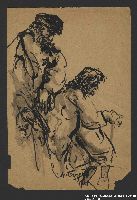
Drawing by Alexander Bogen of a woman sitting with a man standing behind her, both with their heads bowed
Object
Sketch created by Alexander Bogen, depicting an old Jewish couple interned in the ghetto in Vilna, Lithuania. Bogen was an art student in Vilna in 1941 when Germany invaded and occupied Lithuania and neighboring countries. In the Vilna ghetto, he sketched scenes of the life of his fellow Jews interned there by the Germans. “An artist doomed to death,” he said in later years, “recording and so preserving those doomed to death.” In 1943, he escaped the ghetto and joined the partisans in the Naroch Forest in Belarussia, who carried out sabotage and other actions against the occupying German military. He helped lead the all-Jewish Nekama (Revenge) partisan brigade, and reentered the Vilna ghetto to help underground fighters escape as it was being liquidated by the Germans. When Lithuania was liberated in 1944 by Soviet forces, he returned to Vilna and resumed his studies.
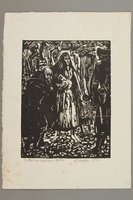
Artwork by Alexander Bogen
Object
Artwork created by Alexander Bogen. Bogen was an art student in Vilna in 1941 when Germany invaded and occupied Lithuania and neighboring countries. In the Vilna ghetto, he sketched scenes of the life of his fellow Jews interned there by the Germans. “An artist doomed to death,” he said in later years, “recording and so preserving those doomed to death.” In 1943, he escaped the ghetto and joined the partisans in the Naroch Forest in Belarussia, who carried out sabotage and other actions against the occupying German military. He helped lead the all-Jewish Nekama (Revenge) partisan brigade, and reentered the Vilna ghetto to help underground fighters escape as it was being liquidated by the Germans. When Lithuania was liberated in 1944 by Soviet forces, he returned to Vilna and resumed his studies.

Drawing by Alexander Bogen of a child in a hooded cloak leaning against a wall
Object
Sketch created by Alexander Bogen, depicting a Jewish child interned in the ghetto in Vilna, Lithuania. Bogen was an art student in Vilna in 1941 when Germany invaded and occupied Lithuania and neighboring countries. In the Vilna ghetto, he sketched scenes of the life of his fellow Jews interned there by the Germans. “An artist doomed to death,” he said in later years, “recording and so preserving those doomed to death.” In 1943, he escaped the ghetto and joined the partisans in the Naroch Forest in Belarussia, who carried out sabotage and other actions against the occupying German military. He helped lead the all-Jewish Nekama (Revenge) partisan brigade, and reentered the Vilna ghetto to help underground fighters escape as it was being liquidated by the Germans. When Lithuania was liberated in 1944 by Soviet forces, he returned to Vilna and resumed his studies.

Drawing by Alexander Bogen of a man wearing a six-pointed star, sitting and holding a cup, with another person standing behind him
Object
Sketch created by Alexander Bogen, depicting a man wearing a six-pointed star. Bogen was an art student in Vilna in 1941 when Germany invaded and occupied Lithuania and neighboring countries. In the Vilna ghetto, he sketched scenes of the life of his fellow Jews interned there by the Germans. “An artist doomed to death,” he said in later years, “recording and so preserving those doomed to death.” In 1943, he escaped the ghetto and joined the partisans in the Naroch Forest in Belarussia, who carried out sabotage and other actions against the occupying German military. He helped lead the all-Jewish Nekama (Revenge) partisan brigade, and reentered the Vilna ghetto to help underground fighters escape as it was being liquidated by the Germans. When Lithuania was liberated in 1944 by Soviet forces, he returned to Vilna and resumed his studies.
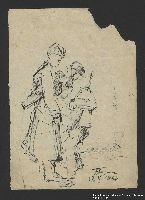
Drawing by Alexander Bogen of two partisans standing close together, one lighting the other’s cigarette
Object
Sketch created by Alexander Bogen while he was a partisan fighter in the Naroch Forest in Belarussia during World War II. The sketch depicts two of his fellow partisans. Bogen was an art student in Vilna in 1941 when Germany invaded and occupied Lithuania and neighboring countries. In the Vilna ghetto, he sketched scenes of the life of his fellow Jews interned there by the Germans. “An artist doomed to death,” he said in later years, “recording and so preserving those doomed to death.” In 1943, he escaped the ghetto and joined the partisans, who carried out sabotage and other actions against the occupying German military. He helped lead the all-Jewish Nekama (Revenge) partisan brigade, and reentered the Vilna ghetto to help underground fighters escape as it was being liquidated by the Germans. When Lithuania was liberated in 1944 by Soviet forces, he returned to Vilna and resumed his studies.
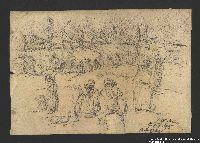
Drawing by Alexander Bogen of groupings of partisans in a wood, including a row of partisans with a flag
Object
Sketch created by Alexander Bogen while he was a partisan fighter in the Naroch Forest in Belarussia during World War II. Bogen was an art student in Vilna in 1941 when Germany invaded and occupied Lithuania and neighboring countries. In the Vilna ghetto, he sketched scenes of the life of his fellow Jews interned there by the Germans. “An artist doomed to death,” he said in later years, “recording and so preserving those doomed to death.” In 1943, he escaped the ghetto and joined the partisans, who carried out sabotage and other actions against the occupying German military. He helped lead the all-Jewish Nekama (Revenge) partisan brigade, and reentered the Vilna ghetto to help underground fighters escape as it was being liquidated by the Germans. When Lithuania was liberated in 1944 by Soviet forces, he returned to Vilna and resumed his studies.
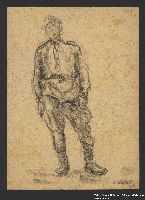
Drawing by Alexander Bogen of a partisan standing in uniform
Object
Sketch created by Alexander Bogen while he was a partisan fighter in the Naroch Forest in Belarussia during World War II. Bogen was an art student in Vilna in 1941 when Germany invaded and occupied Lithuania and neighboring countries. In the Vilna ghetto, he sketched scenes of the life of his fellow Jews interned there by the Germans. “An artist doomed to death,” he said in later years, “recording and so preserving those doomed to death.” In 1943, he escaped the ghetto and joined the partisans, who carried out sabotage and other actions against the occupying German military. He helped lead the all-Jewish Nekama (Revenge) partisan brigade, and reentered the Vilna ghetto to help underground fighters escape as it was being liquidated by the Germans. When Lithuania was liberated in 1944 by Soviet forces, he returned to Vilna and resumed his studies.
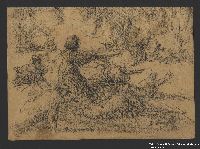
Drawing by Alexander Bogen of partisans firing a cannon
Object
Sketch created by Alexander Bogen while he was a partisan fighter in the Naroch Forest in Belarussia during World War II. The sketch depicts a group of his fellow partisans in battle. Bogen was an art student in Vilna in 1941 when Germany invaded and occupied Lithuania and neighboring countries. In the Vilna ghetto, he sketched scenes of the life of his fellow Jews interned there by the Germans. “An artist doomed to death,” he said in later years, “recording and so preserving those doomed to death.” In 1943, he escaped the ghetto and joined the partisans, who carried out sabotage and other actions against the occupying German military. He helped lead the all-Jewish Nekama (Revenge) partisan brigade, and reentered the Vilna ghetto to help underground fighters escape as it was being liquidated by the Germans. When Lithuania was liberated in 1944 by Soviet forces, he returned to Vilna and resumed his studies.

Drawing by Alexander Bogen of four partisans sitting outdoors with rifles
Object
Sketch created by Alexander Bogen while he was a partisan fighter in the Naroch Forest in Belarussia during World War II. The sketch depicts a group of his fellow partisans. Bogen was an art student in Vilna in 1941 when Germany invaded and occupied Lithuania and neighboring countries. In the Vilna ghetto, he sketched scenes of the life of his fellow Jews interned there by the Germans. “An artist doomed to death,” he said in later years, “recording and so preserving those doomed to death.” In 1943, he escaped the ghetto and joined the partisans, who carried out sabotage and other actions against the occupying German military. He helped lead the all-Jewish Nekama (Revenge) partisan brigade, and reentered the Vilna ghetto to help underground fighters escape as it was being liquidated by the Germans. When Lithuania was liberated in 1944 by Soviet forces, he returned to Vilna and resumed his studies.
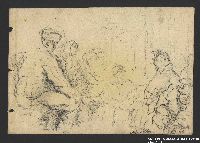
Drawing by Alexander Bogen of a meeting of partisans
Object
Sketch created by Alexander Bogen while he was a partisan fighter in the Naroch Forest in Belarussia during World War II. The sketch depicts a group of his fellow partisans. Bogen was an art student in Vilna in 1941 when Germany invaded and occupied Lithuania and neighboring countries. In the Vilna ghetto, he sketched scenes of the life of his fellow Jews interned there by the Germans. “An artist doomed to death,” he said in later years, “recording and so preserving those doomed to death.” In 1943, he escaped the ghetto and joined the partisans, who carried out sabotage and other actions against the occupying German military. He helped lead the all-Jewish Nekama (Revenge) partisan brigade, and reentered the Vilna ghetto to help underground fighters escape as it was being liquidated by the Germans. When Lithuania was liberated in 1944 by Soviet forces, he returned to Vilna and resumed his studies.
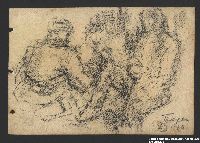
Drawing by Alexander Bogen of three partisans sitting together
Object
Sketch created by Alexander Bogen while he was a partisan fighter in the Naroch Forest in Belarussia during World War II. The sketch depicts a group of his fellow partisans. Bogen was an art student in Vilna in 1941 when Germany invaded and occupied Lithuania and neighboring countries. In the Vilna ghetto, he sketched scenes of the life of his fellow Jews interned there by the Germans. “An artist doomed to death,” he said in later years, “recording and so preserving those doomed to death.” In 1943, he escaped the ghetto and joined the partisans, who carried out sabotage and other actions against the occupying German military. He helped lead the all-Jewish Nekama (Revenge) partisan brigade, and reentered the Vilna ghetto to help underground fighters escape as it was being liquidated by the Germans. When Lithuania was liberated in 1944 by Soviet forces, he returned to Vilna and resumed his studies.
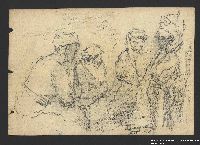
Drawing by Alexander Bogen of four partisans sitting together
Object
Sketch created by Alexander Bogen while he was a partisan fighter in the Naroch Forest in Belarussia during World War II. The sketch depicts a group of his fellow partisans. Bogen was an art student in Vilna in 1941 when Germany invaded and occupied Lithuania and neighboring countries. In the Vilna ghetto, he sketched scenes of the life of his fellow Jews interned there by the Germans. “An artist doomed to death,” he said in later years, “recording and so preserving those doomed to death.” In 1943, he escaped the ghetto and joined the partisans, who carried out sabotage and other actions against the occupying German military. He helped lead the all-Jewish Nekama (Revenge) partisan brigade, and reentered the Vilna ghetto to help underground fighters escape as it was being liquidated by the Germans. When Lithuania was liberated in 1944 by Soviet forces, he returned to Vilna and resumed his studies.

Drawing by Alexander Bogen of a partisan sitting with a rifle
Object
Sketch created by Alexander Bogen while he was a partisan fighter in the Naroch Forest in Belarussia during World War II. Bogen was an art student in Vilna in 1941 when Germany invaded and occupied Lithuania and neighboring countries. In the Vilna ghetto, he sketched scenes of the life of his fellow Jews interned there by the Germans. “An artist doomed to death,” he said in later years, “recording and so preserving those doomed to death.” In 1943, he escaped the ghetto and joined the partisans, who carried out sabotage and other actions against the occupying German military. He helped lead the all-Jewish Nekama (Revenge) partisan brigade, and reentered the Vilna ghetto to help underground fighters escape as it was being liquidated by the Germans. When Lithuania was liberated in 1944 by Soviet forces, he returned to Vilna and resumed his studies.
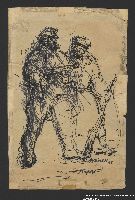
Drawing by Alexander Bogen of two armed partisans standing together
Object
Sketch created by Alexander Bogen while he was a partisan fighter in the Naroch Forest in Belarussia during World War II. Bogen was an art student in Vilna in 1941 when Germany invaded and occupied Lithuania and neighboring countries. In the Vilna ghetto, he sketched scenes of the life of his fellow Jews interned there by the Germans. “An artist doomed to death,” he said in later years, “recording and so preserving those doomed to death.” In 1943, he escaped the ghetto and joined the partisans, who carried out sabotage and other actions against the occupying German military. He helped lead the all-Jewish Nekama (Revenge) partisan brigade, and reentered the Vilna ghetto to help underground fighters escape as it was being liquidated by the Germans. When Lithuania was liberated in 1944 by Soviet forces, he returned to Vilna and resumed his studies.
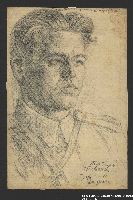
Portrait of a partisan in uniform, drawn by Alexander Bogen
Object
Sketch created by Alexander Bogen while he was a partisan fighter in the Naroch Forest in Belarussia during World War II. Bogen was an art student in Vilna in 1941 when Germany invaded and occupied Lithuania and neighboring countries. In the Vilna ghetto, he sketched scenes of the life of his fellow Jews interned there by the Germans. “An artist doomed to death,” he said in later years, “recording and so preserving those doomed to death.” In 1943, he escaped the ghetto and joined the partisans, who carried out sabotage and other actions against the occupying German military. He helped lead the all-Jewish Nekama (Revenge) partisan brigade, and reentered the Vilna ghetto to help underground fighters escape as it was being liquidated by the Germans. When Lithuania was liberated in 1944 by Soviet forces, he returned to Vilna and resumed his studies.
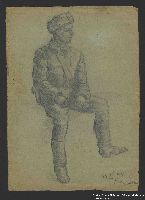
Portrait of a partisan in uniform, drawn by Alexander Bogen
Object
Sketch created by Alexander Bogen while he was a partisan fighter in the Naroch Forest in Belarussia during World War II. Bogen was an art student in Vilna in 1941 when Germany invaded and occupied Lithuania and neighboring countries. In the Vilna ghetto, he sketched scenes of the life of his fellow Jews interned there by the Germans. “An artist doomed to death,” he said in later years, “recording and so preserving those doomed to death.” In 1943, he escaped the ghetto and joined the partisans, who carried out sabotage and other actions against the occupying German military. He helped lead the all-Jewish Nekama (Revenge) partisan brigade, and reentered the Vilna ghetto to help underground fighters escape as it was being liquidated by the Germans. When Lithuania was liberated in 1944 by Soviet forces, he returned to Vilna and resumed his studies.
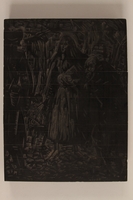
Woodblock designed by Alexander Bogen with 2 scenes: a Nazi menacing a group of Jews, and on the back, two soldiers sitting in the forest
Object
Woodblock designed by Alexander Bogen for printing a scene of a German officer menacing a group of Jews, and on the back, two soldiers sitting in the forest. Bogen was an art student in Vilna in 1941 when Germany invaded and occupied Lithuania and neighboring countries. In the ghetto, he sketched scenes of the life of his fellow Jews interned there by the Germans. “An artist doomed to death,” he said in later years, “recording and so preserving those doomed to death.” In 1943, he escaped the ghetto and joined the partisans in the Naroch Forest in Belarussia, who carried out sabotage and other actions against the occupying German military. He helped lead the all-Jewish Nekama (Revenge) partisan brigade, and reentered the Vilna ghetto to help underground fighters escape as it was being liquidated by the Germans. When Lithuania was liberated in 1944 by Soviet forces, he returned to Vilna and resumed his studies.
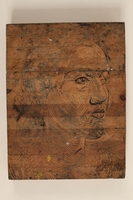
Woodblock designed by Alexander Bogen with 2 scenes: a portrait of a woman; on reverse, a man sitting with a rifle
Object
Woodblock designed by Alexander Bogen for printing a portrait of a woman, and on the back, a man sitting with a rifle Bogen was an art student in Vilna in 1941 when Germany invaded and occupied Lithuania and neighboring countries. In the Vilna ghetto, he sketched scenes of the life of his fellow Jews interned there by the Germans. “An artist doomed to death,” he said in later years, “recording and so preserving those doomed to death.” In 1943, he escaped the ghetto and joined the partisans in the Naroch Forest in Belarussia, who carried out sabotage and other actions against the occupying German military. He helped lead the all-Jewish Nekama (Revenge) partisan brigade, and reentered the Vilna ghetto to help underground fighters escape as it was being liquidated by the Germans. When Lithuania was liberated in 1944 by Soviet forces, he returned to Vilna and resumed his studies.



